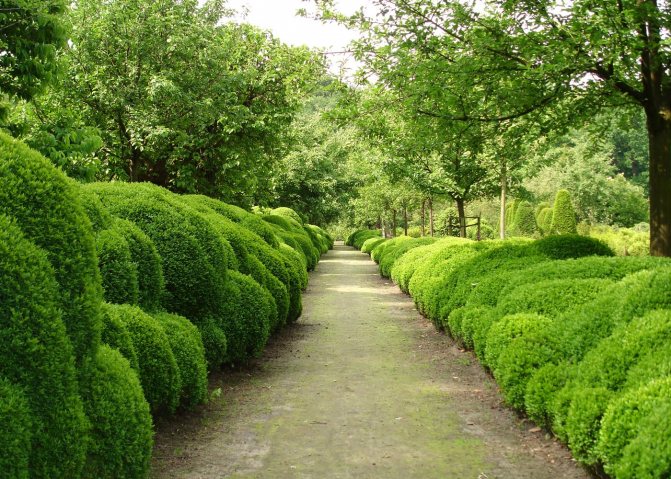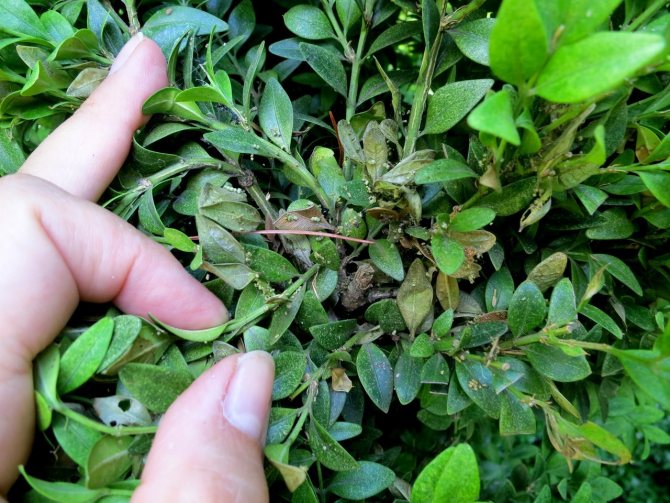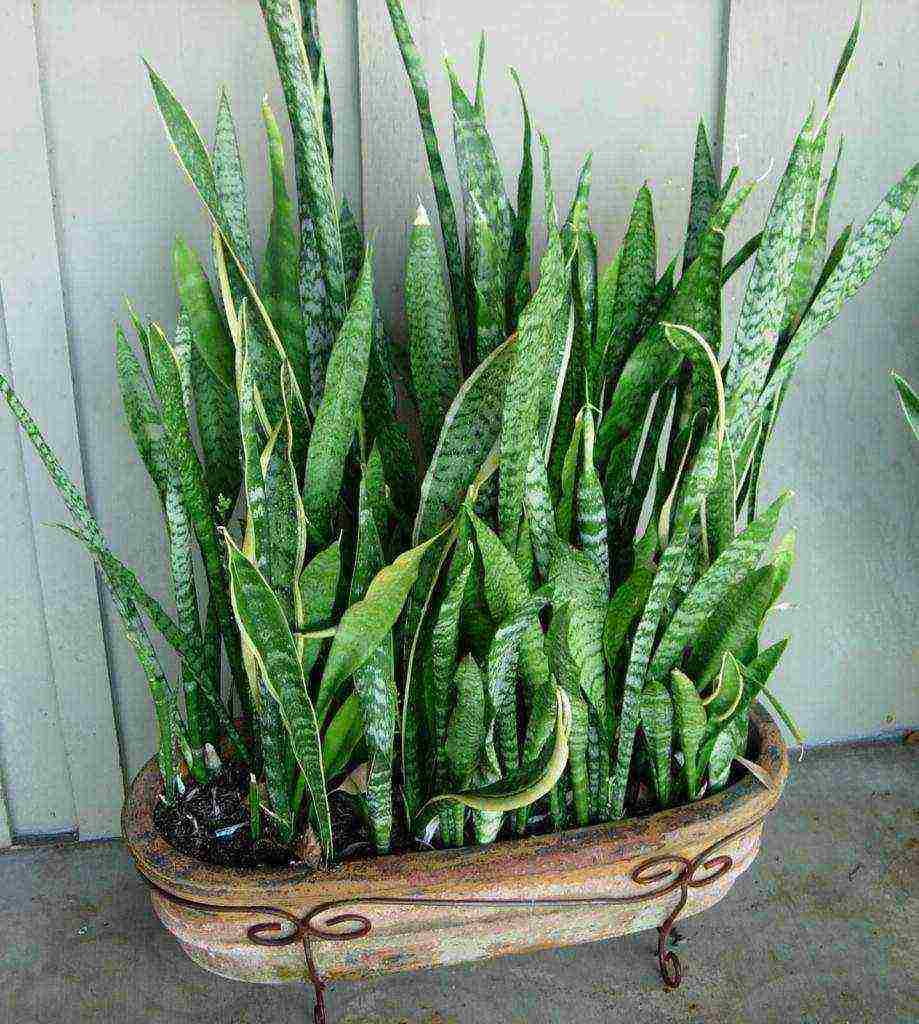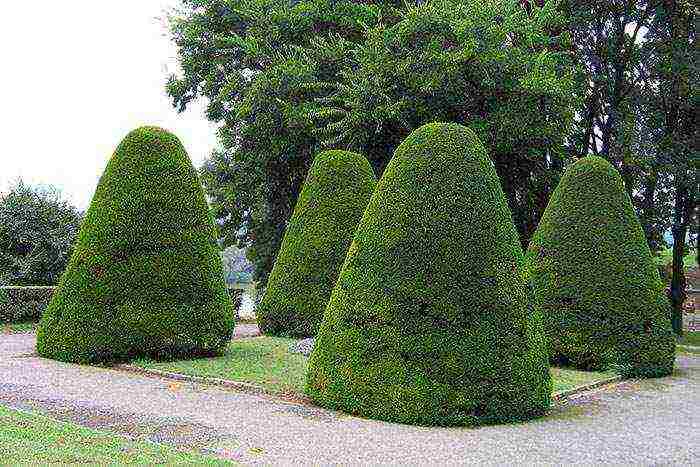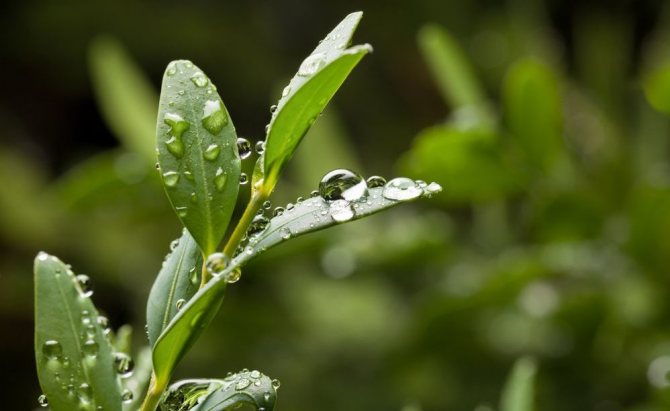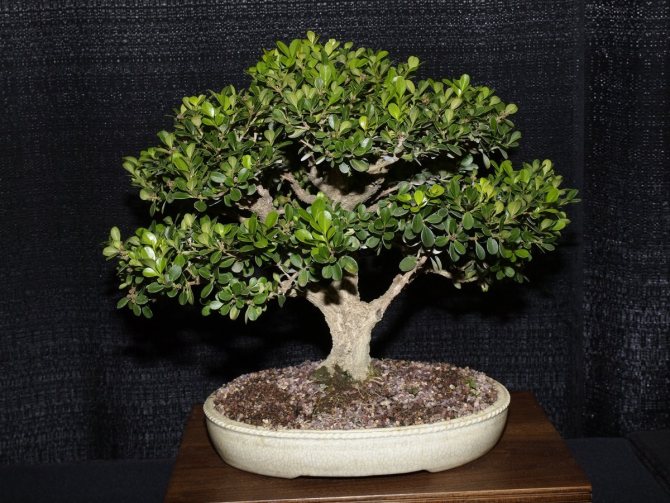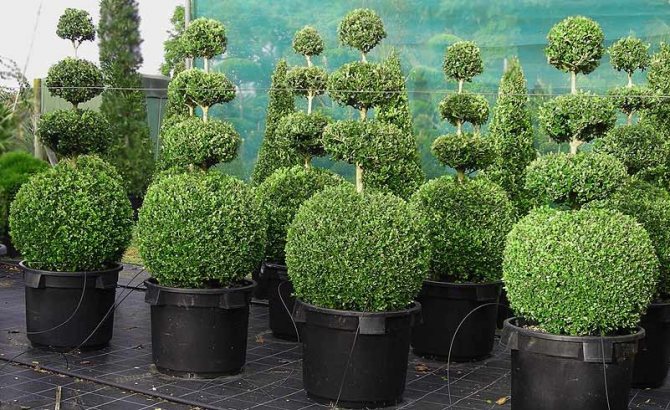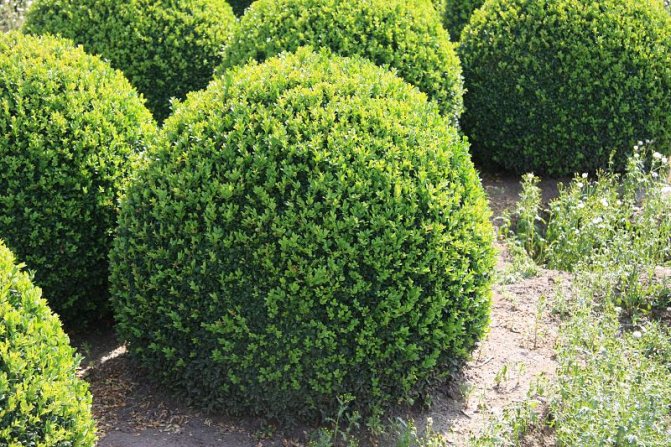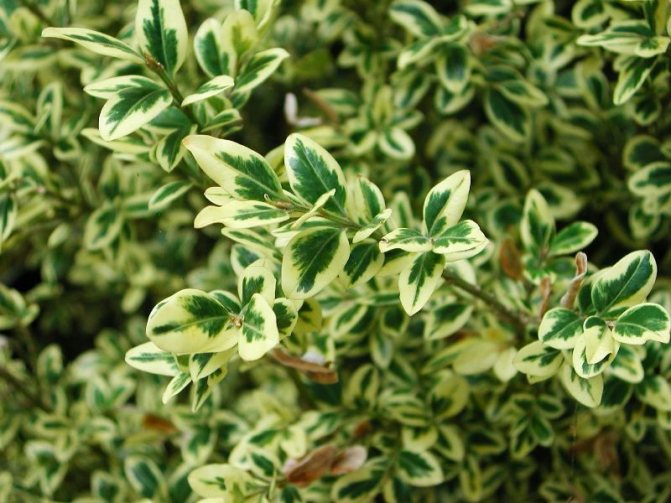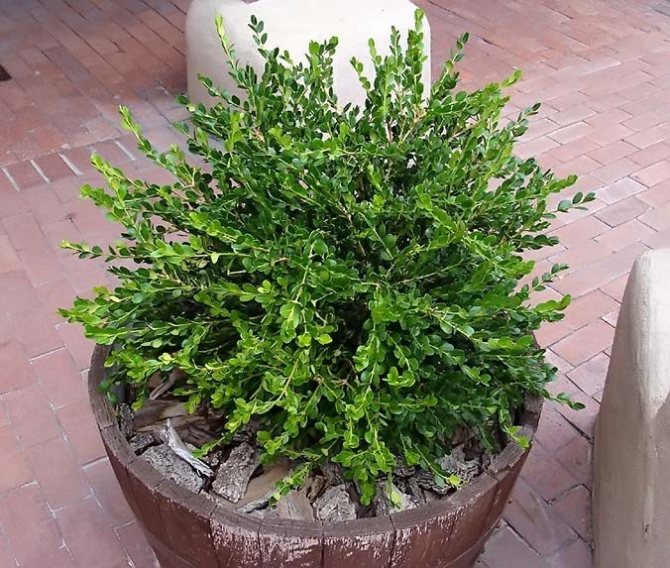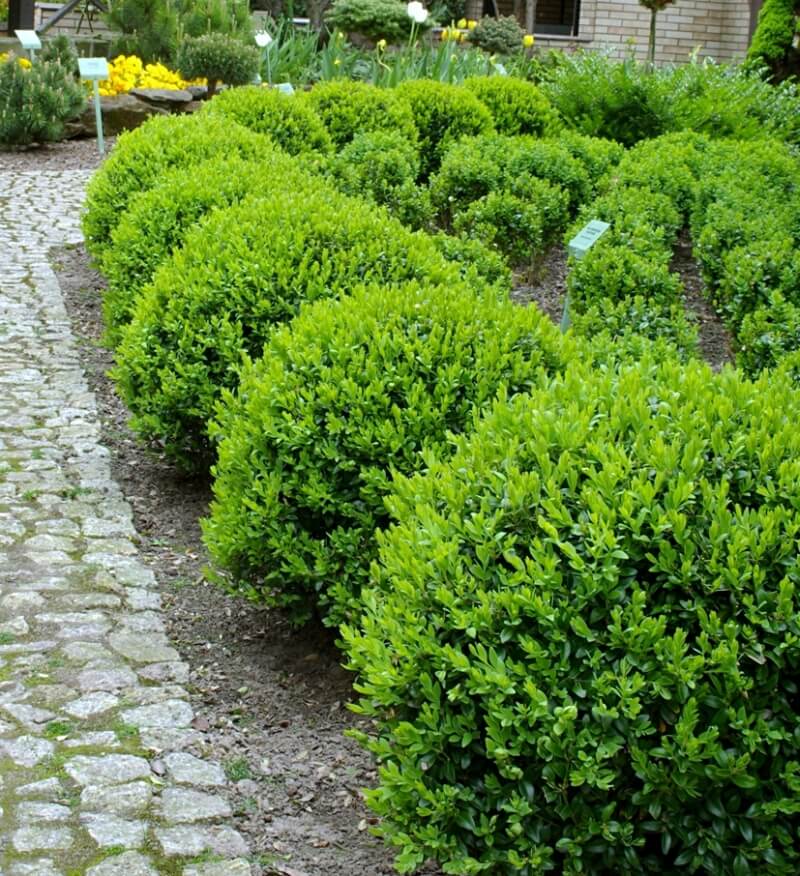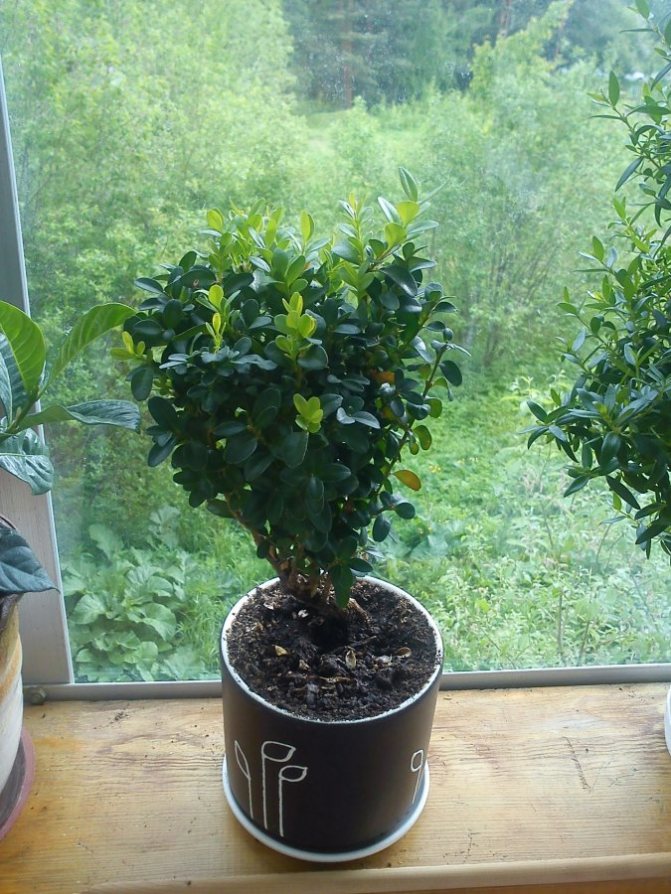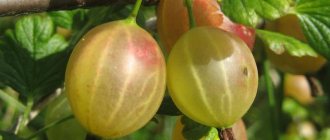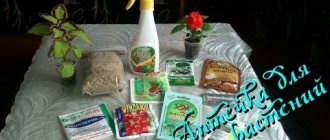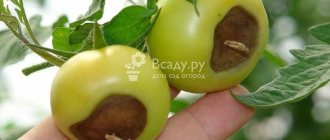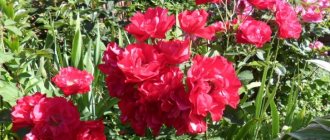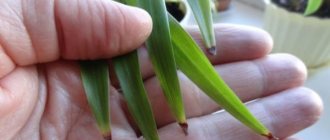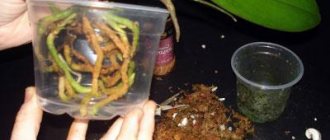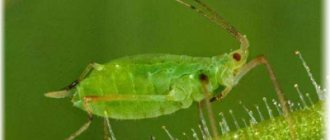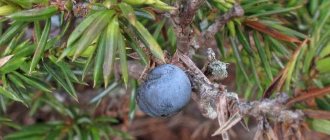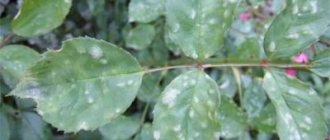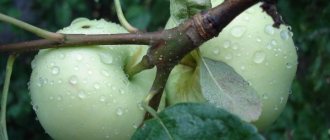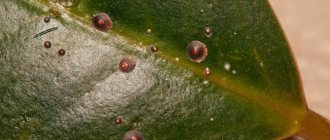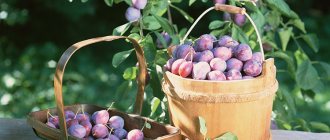More and more primordial garden plants are moving into the rooms. Together with the best annuals and beautifully flowering perennials, numerous evergreens of the garden, for example, boxwood, acquire the status of "indoor". Despite their reputation as a predominantly garden plant, potted boxwoods can beautify more than just terraces. Not the most unpretentious, but charming, albeit poisonous, boxwoods offer to expand horizons and decorate the interior with unexpectedly perfect textures of their dense crown. This is one of the latest additions to the list of indoor garden favorites. How to grow boxwood at home, we will tell in the article.
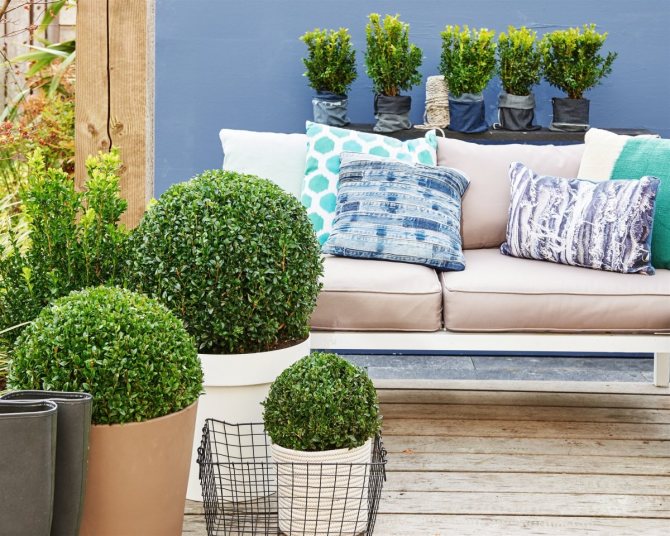
Boxwood in interior design. <>
Lighting
Boxwood prefers bright, diffused light. Optimally, these are windows facing east or west.
The bush should be protected from the direct rays of the midday sun.
It can also grow in low light conditions, for example, on a northern windowsill, however, decorative qualities will suffer.
In the warm season, it is recommended to take the pot out into the garden, outdoors. It is better to put it in natural shade from tall trees and bushes.
Home cultivars
The genus of boxwood has 104 species. Plants have been cultivated for about 300 years both outdoors and indoors. It is appreciated for its rounded leathery green foliage, densely covering the shoots. The branches grow slowly, an average of 5-6 cm per year. This makes it possible to form geometric shapes and more complex structures, for example, animals, from the growth.
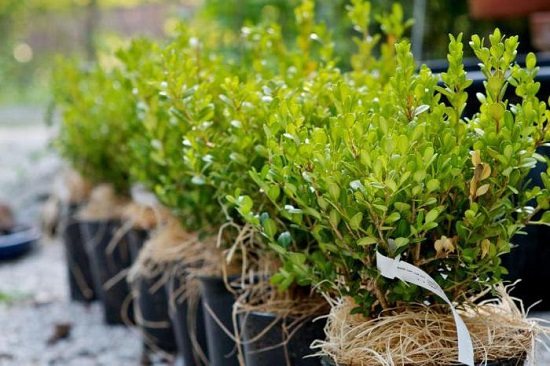

Although tugs are more likely to grow in plots, some varieties can be grown indoors. Boxwood is a poisonous plant, so the flowerpot with it must be isolated from children and pets. At the same time, boxwoods emit phytoncides into the air, which disinfect the room.
Boxwood at home takes root well if you provide it with the proper conditions. Of all the species diversity, varieties of evergreen boxwood, small-leaved and bolear are successfully grown on the windowsill. The Garland species is well suited for creating bonsai.
The best varieties for growing in a pot:
- Elegans is a spherical specimen with bordered oblong leaves;
- Curly Locks attracts attention with bizarrely twisted shoots, his photos leave no one indifferent;
- Marginata with leaves of a pale green color and a yellow border around the edge is ideal for decorating window sills and terraces;
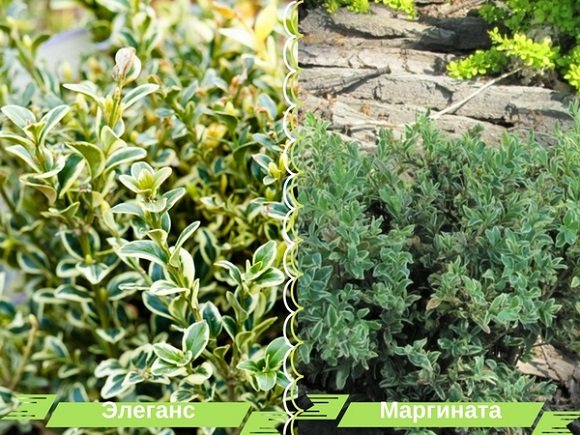

In flower shops you can buy a pot of young boxwood bush. In healthy specimens, leaves of a rich green color, stems are not bare. In a pair with him, novice growers usually buy myrtle, which is not so difficult to cope with at home. Indoor hydrangea and lemon tree will be more capricious.
Temperature
In summer the buksus feels good at normal ambient temperatures. Since he loves fresh air, after the threat of frost, it is recommended to take him out to the balcony or garden. There he can be until the onset of the first autumn cold weather.
Starting in autumn, the temperature of the content should be gradually reduced. In winter, it is recommended to keep boxwood at 15-18 degrees, but not lower than 10.Such conditions can be on a glazed loggia.
Higher temperatures are highly undesirable as the leaves can begin to turn yellow and fall off. Nevertheless, if the thermometer cannot be lowered to the specified range, it is necessary to increase the humidity of the environment by all means.
Gardeners reviews
orest
If the plant is infected with fungal diseases, when warm weather sets in, treat it with Ditan, Hom. But don't expect an immediate miracle. The plant will slowly heal.
Ky!
In case of illness, spray with a powerful fungicide, for example, foundationol or Ridomil Gold.
Watering
In the warm season, boxwood should be watered abundantly and often, as soon as the topsoil dries up.
It should be remembered that both overdrying and excessive soil moisture have a negative effect on the plant. Therefore, the water from the sump must be poured out 15-20 minutes after watering.
In winter, watering is significantly reduced and becomes moderate. The next moistening of the earth is carried out after the top layer of the soil dries well.
Watering is carried out with warm water, settled for 1-2 days. This will prevent decay of the root system.
Prevention measures
After the damaged leaves are removed, it is necessary to re-start the stage of crown formation. To avoid the moments when the boxwood turns yellow and withers, it is better to worry in advance about a number of preventive measures aimed at maintaining the health of the plant. Every gardener needs to take care of:
- regular cleaning of near-trunk circles and removal of debris accumulated in the area;
- periodic thinning of the boxwood crown;
- installation of visors and sun screens;
- a sufficient drainage layer to drain off a large amount of moisture.
To protect boxwood from suddenly yellowed leaves, it is necessary to periodically apply a complex of fertilizers. Potassium groundbait is introduced in the autumn. Spring is the best time for nitrogenous fertilizers. In summer, you can limit the amount of minerals, but it is important to keep the watering schedule.
Spraying
In summer, boxwood should be sprayed twice a day - in the morning, before the sun's rays, and in the evening, after sunset.
For spraying, a fine-grained spray bottle is used and warm settled water. This will help not only increase the humidity of the environment, but also remove dust from the leaves.
From time to time you can arrange a warm shower for the buxus. Thanks to such measures, the leaves will not dry out and curl, and the likelihood of pests will decrease.
In winter, the frequency of spraying is reduced to 1 time in 1-3 days, depending on the level of humidity and temperature.
Fungal diseases and pests of boxwood
A very complex and dangerous disease of boxwood is tissue necrosis. Its causative agent is a fungus, the smallest spores of which are carried through the air. Necrosis is noticeable from early spring - young shoots and leaves turn yellow and begin to dry out. If a disease is detected, it is necessary to treat the plant with fungicides, and remove the damaged areas. A diseased plant is cut quite deeply, down to the level of healthy tissues. In order for the growing shoots to be healthy, secondary treatment with chemicals is recommended.
Buxus leaves can dry out during an invasion of boxwood gall midge. In early summer, this insect, similar in appearance to moss, lays eggs on young shoots and leaves of the plant. By winter, the hatched larvae penetrate deep into the leaf tissue. By May next spring, adult insects appear from them. If there are too many insects, the leaves of the boxwood dry out and quickly begin to fall off. Various fungicides are used to effectively kill these insects. To obtain the best result, the chemical treatment is repeated after 10 days.
If the leaves of the boxwood are curled up, this may be a sign of a lice plant on it. At the same time, the leaves of the plant dry and deform. The surface of the leaf plate is covered with a wax coating, under the protection of which the larvae of the pest are located. To get rid of the insect, the plant is treated with mineral oil (you can take it in the form of a spray) and be sure to cut off the damaged leaves and parts of the shoots.
Boxwood stands can be severely affected by the small moth-like insect - the boxwood moth. In our area, it was registered quite recently - in 2012, but it spread rather quickly. The invasion of colonies of these insects can destroy entire groves. Trees are covered with cobwebs at lightning speed, the leaves curl and begin to dry out. At the same time, a specific smell is felt everywhere. To destroy these pests, box trees are treated with biological insecticides, the chemical is sprayed not only on the tree itself, but also on the soil around it. The type of chemical is determined by the degree of development of the moth larvae.
Boxwood leaves become covered with yellow specks, and later become discolored and dry out in the presence of a spider mite. These small insects settle on the underside of the leaf among their own cobwebs. Ticks appear in summer when the weather is hot and the humidity is very low. A small amount of this pest can be simply washed off with soap and treated with mineral oil. If there are a lot of ticks and the lesion is strong, then you cannot do without the use of chemicals.
Finding that the boxwood has turned yellow is a very unpleasant discovery for any gardener. After all, it takes years to grow even a small beautiful bush. The loss of decorativeness is not the worst consequence of yellowing of evergreen leaves. If you do not understand the causes of chlorosis in time and do not correct the situation, over time you can lose the entire plant.
The soil
Soil for boxwood should be nutritious with neutral acidity.
You can buy a ready-made substrate for decorative deciduous plants.
To prepare the soil mixture yourself, you should take 2 parts of leafy land, 4 parts of sod land and 1 part of sand.
Another option is 1 part of coarse sand and coniferous land, 2 parts of leaf land. It is good to add some charcoal.
Before planting, the soil must be disinfected., holding 15 minutes in a heated oven or spilling a pink solution of potassium permanganate. It is imperative to lay a drainage layer at the bottom of the pot, consisting of expanded clay, clay shards or foam.
Care Tips
As already mentioned, boxwood does not belong to whimsical plants. It is grown without much difficulty in the open field, but with the same success it can be obtained from boxwood at home, in a flower pot.
This plant does not need a special light regime, a flowerpot with a buxus can be placed both on a sunlit windowsill and on a completely shaded one. For the successful development and growth of boxwood at home, room temperature is quite suitable. In winter, when its biorhythms slow down naturally, it is recommended to lower the temperature of the content to 15 degrees.
In summer, the buxus requires abundant watering. Water it as soon as the soil dries up. In the cold season, when the air temperature drops, watering is reduced to moderate. It is important to prevent excess water near the root system - waterlogging can provoke root rot.
The humidity for keeping indoor boxwood should be moderate. If the plant is looked after correctly, then its leaves must be sprayed from time to time. This procedure will prevent the leaves from drying out and curling, and will also protect the plant from pests.
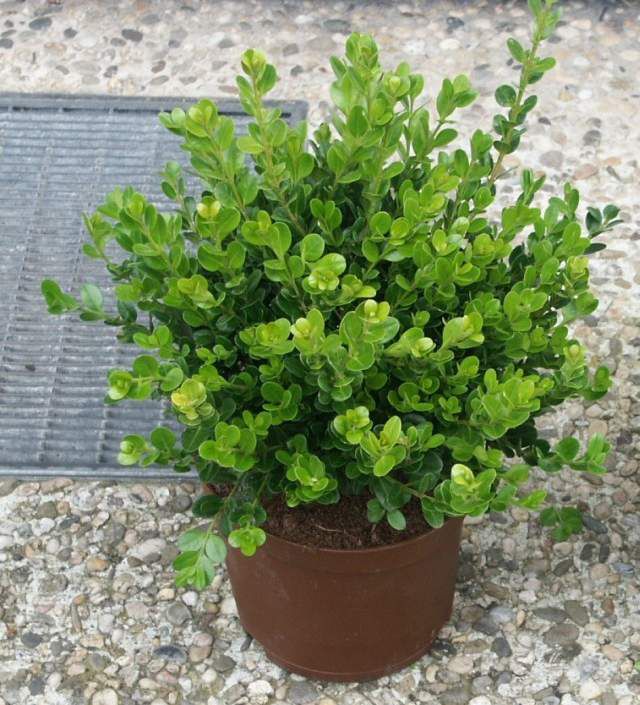

Boxwood is rarely transplanted - it is very slow in growth. One transplant is enough for several years.The transplant is usually done at the beginning of spring - at this time the processes of plant growth and development are activated. The next flowerpot for this box must be larger than the previous one.
Boxwood usually does not get sick during transplantation, but it is important to make sure that there is a drainage at the bottom of the pot that performs its functions well (this is perhaps the basic rule for caring for boxwood at home) Excess moisture near the roots is very often the cause of plant diseases.
Read also: Transplanting indoor flowers: when and how to do it correctly
The soil for the skid must be structured and nutritious. Specialized stores offer a ready-made soil substrate, but you can prepare it yourself. To do this, you need to take 4 parts of sod land, 2 parts of leaf and 1 part of sand with large particles. It is better to transplant a plant bought in a store immediately - it is usually sold in the so-called transport soil, which is not as nutritious and dries up quickly. They are transplanted very carefully - it is important not to injure the roots. The day before transplanting, the seedling of the buxus is watered abundantly - this will make the soil ball softer.
Boxwood can be propagated in two ways - by cuttings or from seeds.
When propagated by cuttings, twigs are cut from adult and healthy plants. This is usually done in April or May. At the same time, shoots are taken that have grown during the last year (a small part of the year before last is acceptable). The length of the cutting should be 15-20 cm. The cut branches are embedded in the soil with the addition of a rooting stimulator and covered for a while with a transparent vessel, building something like a small greenhouse. When boxwood reproduces in this way, the appearance of roots should be expected in a month, the full rooting of the plant occurs only by autumn.
Seed propagation of this plant is more painstaking. First of all, its difficulty lies in the fact that buxus seeds quickly lose their germination. Therefore, it is better to sow the change immediately after harvesting or store it in a glass container in the refrigerator until spring. It is better to stratify the seeds bought in the store - they are kept in wet sand at a temperature of +5 degrees for two months. After this procedure, which significantly increases the germination of seeds, they are sown in a flowerpot and covered with a film for the first time. For germination of seeds, maintain a temperature of +15 degrees. Germination time is quite long - from 1 to 3 months.
Experience shows that even a beginner can grow boxwood at home. You just need to be patient - and you will receive an original decoration of your home.
Fertilizer
The plant should be fed in spring and summer 1 time in 10-14 days. Liquid fertilizers for decorative foliage plants or for azaleas can be used for this purpose.
An alternation of root and foliar dressings is recommended.
In the fall and winter, you do not need to fertilize boxwood.
It is recommended to feed the shrub with fertilizers, which include a nitrogen component, during the growth period in spring and summer. At the end of summer, formulations containing only potassium and phosphorus can be added to prepare the plant for the winter period. Fertilizers are applied only to wet soil a few hours after watering.
For foliar feeding, special formulations are used.... You can use the same fertilizers as for root application, but they need to be diluted with water so that their concentration is 2-3 times less than the standard.
What to do if boxwood turns yellow and dries
The color-changing leaves of a favorite shrub can be discouraging for any gardener. As soon as the shoots of boxwood begin to turn yellow, it is necessary to establish the cause of this phenomenon as quickly as possible. It is the onset of the disease that is noticed in a timely manner that will help keep the bush alive.
In addition to complying with all standards for care, watering, fertilization and disease control, you need to take care of the trunks. If the boxwood begins to turn yellow, this may indicate a lack of oxygen to the roots. In this case, it is recommended to loosen and increase the diameter of the trunk circles.
Do not forget about the simplest option, in which the leaves begin to turn yellow - sun damage. Many novice gardeners can easily forget about such an insignificant reason. For this, mobile shading screens are used, which are installed during long sunny days.
What to do if boxwood dries up and the reason is not established
If all possible factors have been checked that may cause damage to the plant, but the boxwood continues to turn yellow and dry, you can seek help from qualified specialists. They will help you find out the cause of wilting by making the necessary measurements and analyzes. Perhaps the soil in the garden is unsuitable or there are other plants that are bad for it next to the shrub.
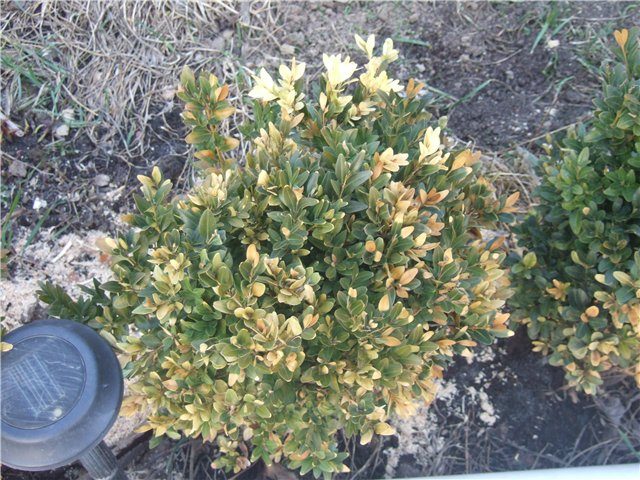

If the cause of wilting is not established, you need to seek help from specialists.
It is worth remembering that if the boxwood turns yellow and dries, then the damaged leaves must be completely removed. This will keep the shoots healthy. When cut, it should have a green core - evidence of a properly functioning plant.
Humidity
Boxwood does not tolerate low humidity conditions; it prefers moderate or high humidity levels. Otherwise, the leaves begin to turn yellow, dry and fall off. Pests may appear.
Several methods can be used to increase the humidity of the environment.:
- Put a flower pot in a tray filled with wet sphagnum, pebbles, expanded clay;
- Place containers with water around the plant;
- Use a humidifier;
- Spray the bush regularly;
- Place a damp cloth on the radiators during the heating season.
Preventive actions
It will not be possible to return the color to a boxwood that has turned yellow. The affected branches will have to be removed and the formation of the bush will start again. It is much easier to take care of the plants in advance.
Preventing boxwood discoloration and drying out includes the following activities:
- Regular removal of garden debris (leaves, branches) from the trunk circle and the center of the bush. In this way, the multiplication of pathogenic spores and bacteria can be avoided.
- Annual crown thinning, especially in the center. Excess shoots are removed until the location of the internal branches in the bush can be accurately seen.
- Advance installation of screens or visors from the spring sun. Works are carried out no later than mid-February. You can simply cover the box with an opaque breathable material.
- Providing a sufficient drainage layer even at the stage of laying the planting holes. If the bush has already turned yellow from waterlogging, you can try to carefully dig it up, pour at least 10 cm of pebbles, bark, coarse sand, rubble under the roots. After that, plant the plant in place again.
Be sure to carry out regular feeding of boxwood. In autumn - with potassium content, to maintain frost resistance. In spring, complex compounds with the obligatory presence of nitrogen. In the middle of the season, if the leaves are bright, green and not a single shoot has turned yellow, boxwood can only be watered without adding fertilizer.
Trim / Support / Garter
As needed, preferably between April and July, boxwood can be pruned.
Pruning stimulates active branching, the crown becomes thicker, old shoots are not exposed.
This will help shape the beautiful appearance of the plant and even create various geometric shapes - a ball, a cube, a cone. Also, boxwood is suitable for growing in the form of bonsai.
When pruning annually, remove all damaged and weak branches.... Dry shoots must also be removed. The remaining branches are pruned, giving the bush the desired shape.It must be remembered that boxwood grows very slowly, so it may not tolerate strong pruning. You need to be very careful when pruning branches. During regular pruning, the shoots of the plant can be shortened by no more than 2-3 cm.
Varieties
Nowadays, boxwood is widely used in the art of landscape design. Let us consider in more detail the types of this plant that are used in this area more often than others.
Boxwood evergreen in nature grows in the Caucasus Mountains and the Mediterranean countries. Unpretentious to lighting, it is equally good both in partial shade and in sunny areas. Without timely pruning, it can be quite high - up to 3 meters high.
Small-leaved boxwood is a dwarf shrub. Compared to the previous relative, it tolerates winter cold better. This species comes from South Asian specimens, and can survive a 30-degree frost without shelter. Differs in compact form and decorative crown. It is quite suitable for growing in a flowerpot.
Bolear boxwood is the largest representative of the family, the leaves are long - up to 5 cm. It came to us from the Bolean Islands (Spain). In the wild, it is found in the mountainous areas of southern Spain, Portugal and on the shores of the Crimea.
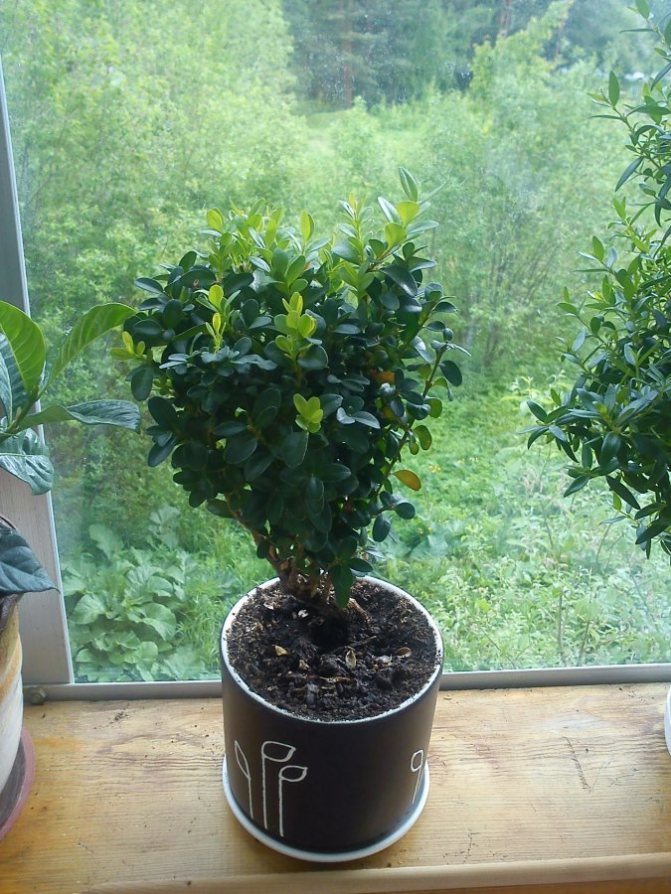

Diseases
Growing boxwood at home and in the garden can be accompanied by plant diseases.
Boxwood is susceptible to a disease like psilla. Its manifestations are leaf deformation, growth retardation, and the appearance of sticky waxy formations.
In this case, the affected parts are removed, and the plant is treated with a fungicide.
Of the pests, the scabbard, spider mites, and aphids can pose a danger to the buxus.
If they appear, the bush is treated with soapy water.
If the pests do not disappear, an insecticide is applied: Actellik, Nurell-D or Fitoverm.
Plant characteristics and features
Recently, more and more people began to grow it as a home, indoor plant. The reason is the beneficial properties that boxwood has. The plant releases phytoncides into the air. These volatile substances are able to neutralize harmful bacteria that accumulate in the air. It also has a pleasant smell, which is released during flowering or when pressed on the leaves.
It should be noted that only three types of plants are suitable for indoor cultivation:
- small-leaved. The maximum length of the leaves of such a box tree reaches 2.5 cm;
- bolear. This plant has larger leaves, up to 4.5 cm;
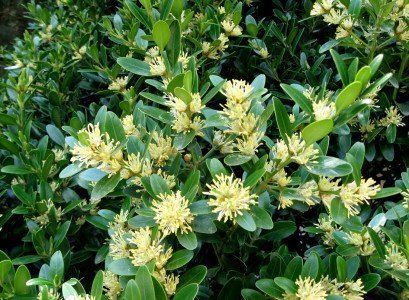

- evergreen. This kind of boxwood is the most common. The length of its leaves reaches three centimeters.


You should pay attention to the fact that evergreen boxwood at home is quite whimsical. With the wrong care, he can easily shed the leaves.
Problems
- Leaves begin to dry and curl - a signal of insufficient watering or low environmental humidity;
- Brown spots on the leaves appear due to over-watering;
- In winter, the bush begins to shed its leaves at temperatures above 18 degrees.
Boxwood is poisonous and can cause intoxication of the body, you only need to work with the plant with gloves!
Mass fall of boxwood leaves can begin when the earthen coma in a pot or tub is completely dry.
Light dry spots on the leaves - sunburn... The plant does not tolerate direct sun, especially in summer. It is best to keep it in diffused light or partial shade.
The shoots of the plant stretch out and weaken, the bush takes on an untidy appearance, the density of the crown decreases - the plant does not have enough light. When the boxwood bush is kept in the shade, it can very quickly lose its decorative effect.
Types of indoor boxwood
Boxwood species are rarely distinguished from each other. Most often, when buying a ready-made indoor plant, you can see the marking "common boxwood" or just the name of the plant.But it would be a big mistake to think that a single species of the entire genus of box trees is grown in the rooms - the dominant one in landscape design as well.
Common boxwood or evergreen (Buxus sempervirens) is a visiting card of box trees, a species that can be transferred to a pot culture and grown indoors. But in room culture, two other types of boxwood, which have more interesting foliage and a thickened crown, with compact sizes, show their properties better. Common boxwood is much more capricious, often sheds leaves, does not forgive mistakes in care.
Small-leaved boxwood (Buxus microphylla) is a densely leafy, strikingly curly shrub. With leaves only up to 2.5 cm long, this boxwood is distinguished by slow growth, perfectly retains its shape and silhouette, practically requiring no frequent pruning. Due to its dense crown, it is considered the ideal boxwood for potting, it is the best choice if you want to create a strict "flawless" silhouette.
Bolear boxwood (Buxus balearica) is a very beautiful shrub with rather large, oval leaves, famous for its ornamental pattern, ceremonial appearance, bright, rich medium-green color. Leaves can exceed 4 cm in length. Due to its rapid growth, it is one of the best plants for experimenting with topiary art.
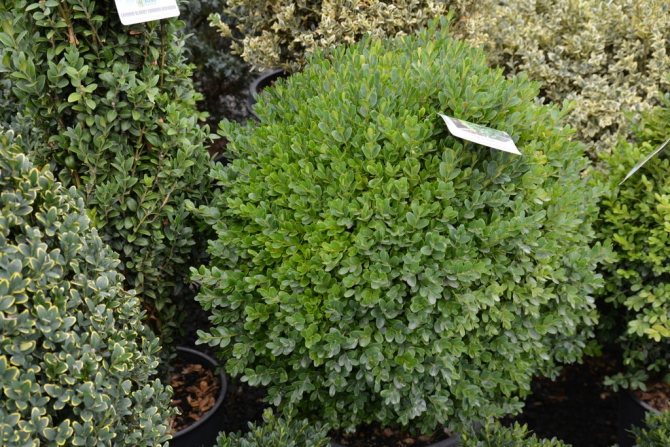

Boxwood ordinary or evergreen (Buxus sempervirens).
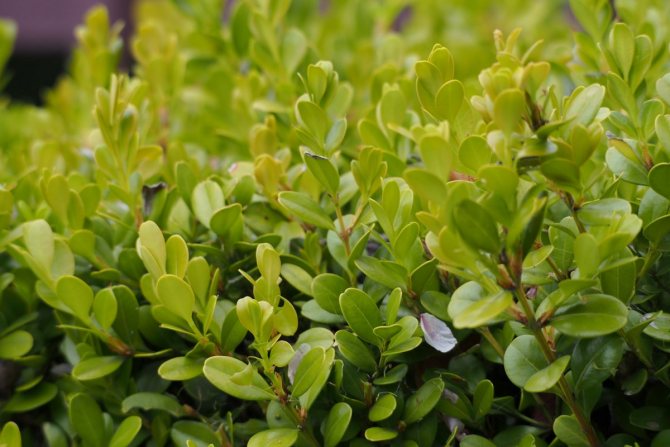

Small-leaved boxwood (Buxus microphylla). <>
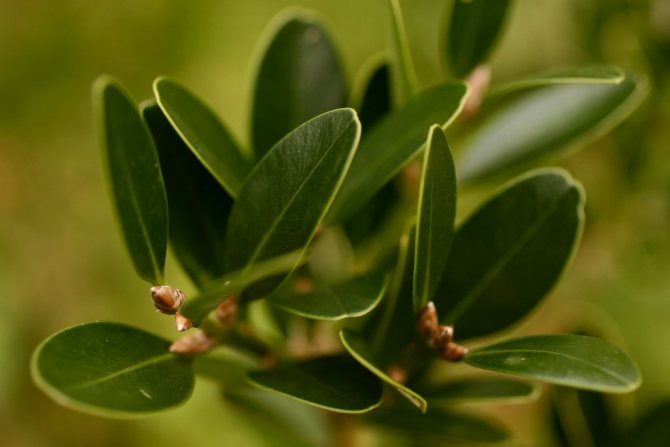

Bolear boxwood (Buxus balearica).
Reproduction
Consider how to propagate boxwood. In indoor conditions, boxwood propagates by cuttings and layering.
For propagation by cuttings: lignified cuttings are cut in late spring or summer. The length of each of them should be no more than 10 cm. The presence of 2-3 internodes is mandatory.
Before planting, treatment with a rooting stimulant is recommended. Cuttings are planted in a mixture of peat and garden soil, covered with foil.
After 3-4 months, after rooting and engraftment, young specimens are seated in individual pots.
For propagation by layering: one or more shoots are pressed to the ground with wire staples. To accelerate the emergence of roots, the soil should be well moistened, warmed up a little, you can use growth stimulants.
Rooting takes place within 3-4 weeks. After the new specimen has taken root well, it is cut off from the mother plant and planted in an individual pot.
Reproduction of boxwood
With proper care, it is quite easy to propagate evergreen boxwood at home. It should be noted that this plant reproduces with the help of cuttings and seeds.
Cuttings are best cut at the end of summer. It should have two or three internodes and be no longer than seven centimeters. Then the plant will take root, and will grow and bloom for a long time.
Put the prepared cuttings in water until the roots appear, or lower them immediately into a pot with soil.


Now everyone knows how to care for boxwood and can independently create a unique atmosphere of the Garden of Eden in their apartment, which remains evergreen for many years.
Transfer
Due to the fact that the boxwood grows slowly, it should be transplanted once every 2-4 years, when it becomes very cramped in the pot.
The optimal time for transplanting is spring.
The plant does not like large containers, so the new pot should not be much larger than the previous one.
Since the roots of the buxus are quite brittle, the best way to transplant is transshipment.
Caring for a boxwood bush at home
Onboarding a rookie begins with proper placement. Evergreen pots are set up in areas with little shade, as in the case of outdoor cultivation. Foliage can be affected by excess sunlight. The best location would be a west or east window.Lack of light can also negatively affect growth, so you should not send it deeper into the room.
From time to time, you can take out the pot with the buxus to an open space. In the fall, the plant enters a state of dormancy, it should be transferred to a warmed glazed loggia. Another wintering option is on the floor by the balcony door. The admissible temperature in summer is room temperature, in winter it is from +10 to + 15 ° C. From dry air and high temperatures, the tree can shed its leaves.
- Watering, top dressing in summer and winter
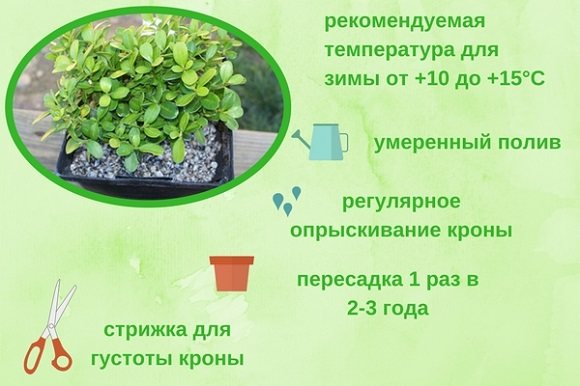

Indoor boxwoods are sensitive to humidity. They need not only to be watered regularly, but also to be sprayed. If there is not enough moisture, then the edges of the leaf blades will begin to dry out. During the growing season, to stimulate the growth of shoots, it is useful to add bioregulators (Epin) to the water prepared for spraying. If the air in the room is dry, boxwood leaves will immediately begin to curl, pests (scale insects, spider mites) will appear on the crown.
It is necessary to constantly monitor the condition of the soil and prevent it from drying out.
As soon as the topsoil dries up, add an additional portion of moisture. In winter, watering is reduced to moderate. Spraying is done less often, they do this to prevent foliage from curling.
Home care for buksus consists in timely feeding with nutritional complexes. Fertilizers are taken for evergreens; complexes for ficuses or azaleas are suitable. The frequency of feeding is 1 time per 2 weeks. For example, hibiscus at home is more voracious, it is fed every week since March. Be sure to carry out a feeding procedure before cutting, since fertilizers stimulate the growth of green mass.
Video about getting new specimens from cuttings.
Changing the container is a rare event, as the plant develops extremely slowly. It is enough to change the container every few years. The transplant is done in early spring, the pot is selected a little more than the previous one.
The soil for plants should not be acidic.
The approximate composition of the substrate: 1 part of coarse sand + 2 parts of leaf land + 1 part of coniferous land. You can add a little bone meal to the composition. A drainage layer at the bottom of the tank is required, since the root system does not tolerate stagnant water well. After the transplant, the rules of care remain the same. From above, the substrate is covered with sphagnum to retain moisture and aesthetics. The moss is changed every 3 months.
The main reason to grow a boxwood tree is the formation of various shapes from it. A haircut thickens the crown, makes it thicker. Pruning is carried out throughout the year as needed, but only from the second year of life. Before starting cultivation, you need to think over the final shape of the bush. Special metal templates may be needed. They are usually used to shape shrubs into animals.
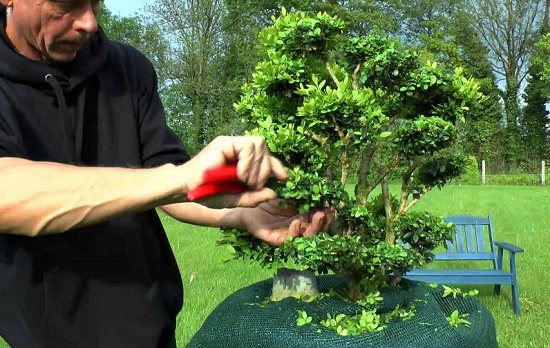

Bonsai also looks beautiful on the windowsill. To create it, shoots are cut from the bottom of the bush, and the top is formed in the form of a ball or drop. To create inclined delights, the shoots are fixed with wire, giving them a certain angle of inclination.
You need to take care of the plant carefully. Since its foliage contains toxic substances, all work is carried out in protective gloves. After contact with the plant, hands should be washed.
Boxwood in the garden
Consider planting and caring for boxwood outdoors. Boxwood has long been used for landscaping gardens and parks. In warm regions, this plant is cultivated outdoors. Boxwood is appreciated for its decorative effect. This shrub has very small leaves and a dense crown.
With formative pruning, it can be shaped into almost any shape. The gardens and parks are decorated with conical and spherical boxwood crowns, as well as numerous hedges.
Boxwood is planted in mid-September in a pre-prepared planting pit in a place protected from direct sun. In this case, before the onset of cold weather, the plant will be able to root well.The hole should be three times larger than an earthen lump with plant roots.
The soil for planting boxwood must be permeable and very fertile. Garden soil taken out of the hole, mixed with perlite in equal parts, is quite suitable. During planting, starting nitrogen fertilizers are laid in the soil.
The day before disembarkation, the landing pit is spilled with water. Then, drainage from perlite and expanded clay is laid on its bottom and filled with 1/3 of earth. The plant is planted, covering the roots with prepared soil. After planting, the soil is slightly compacted, and the bush is well watered.
Seedling care is very simple. First, they need to be watered weekly, watered less often as they grow. Water consumption - 10 liters per 1 seedling 1 m high. Plant feeding is carried out only next year in spring, when it takes root well and starts growing. In the spring and summer, they are fed with nitrogen fertilizers, in the fall - with potash and phosphorus fertilizers.
Overgrown boxwood bushes must be formed... This plant tolerates sparing pruning well. This makes its crown only thicker. It is necessary to form the bushes in the spring, and in the summer you can periodically, no more than 1 time in 1-2 months, carry out the crown correction.
There are frost-resistant varieties of boxwood that can withstand temperatures down to -10 ... -15 ° C. But in the temperate climate of the middle zone, when the winter temperature often drops below 20 ° C, it must be covered.
Now you know everything about planting, caring for and breeding boxwood at home and in the garden (open field), and also saw a photo of the plant.
Boxwood in nature and in the room - differences and features
Boxwood is one of the most recognizable evergreen shrubs. This plant has long become a "must" not only in urban landscaping, but also in garden design. Boxwood is the main star of regular gardens and topiary. It is easy to recognize by both its growth pattern and the beauty of its strikingly dense foliage. But if in gardens or parks boxwood has long been perceived as a classic, then in the room it causes, at least, surprise.
Boxwood is such a "garden" plant that it is very difficult to imagine it in a closed space. But in recent years, along with the best conifers, boxwoods have begun to conquer new heights as indoor plants. In our country, they still seem like a curiosity and a novelty, but in the West they have long become one of the wonderful alternatives to the usual decorative leafy accents.
The first designers who flirted with the oriental style began to introduce boxwood into the interiors of the rooms. Today, boxwood is the main star of Chinese and Japanese restaurants, an amazing accent in modern interiors with a focus on minimalism.
In nature, boxwoods are found throughout the Northern Hemisphere, they are especially common in North Africa, the Mediterranean, and Western Asia. As an ornamental plant, boxwood is one of the most popular plants on our planet. These are representatives of the family of the same name Boxwood.
The exterior of indoor box trees is as recognizable as ordinary garden box trees. Despite the maximum declared height of 1 m, the shrub in the rooms is usually limited to 30-60 cm. It is a densely branched, compact, slow-growing evergreen with an amazingly dense crown. Straight shoots are densely covered with sessile leaves in pairs. Small, up to 3 cm, glossy, with a central vein, elongated oval leaves of boxwood are easily recognizable not only by the characteristic shade of a dark green color, which changes on the back side to a lighter one, but also by a pleasant smell.
Boxwood seems ideal in terms of density and crown texture. The plant by nature flaunts with dense contours, but indoor boxwoods, like garden ones, are grown only with the formation of strict silhouettes. Boxwood can be set to any direction of growth and any contour. Boxwoods do not bloom in rooms.
Beautiful green boxwood in the interior beckons to touch.But you need to be careful with the plant. All parts of box trees are poisonous, they contain dangerous alkaloids. The toxicity of the plant should be considered not only when pruning, but also when choosing a placement, because this plant is not suitable for growing in homes with small children or pets.
Home boxwoods fully reveal their phytoncidal talents. The plant is considered one of the most beneficial shrubs that can cleanse the air of bacteria and toxins.
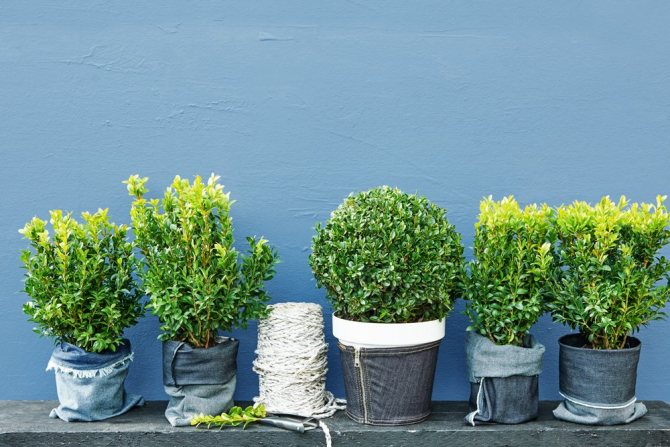

Boxwoods in pots. <>
Photo
When and how is the best time to replant boxwood?
Experienced gardeners believe that replanting and planting box trees is better in the fall, like other plants that bloom in spring. It is important to remember that rooting boxwood in the soil requires at least one month, so planting in open soil must be done a month before the first frost, or better, earlier.
At the bottom of the pit, during transplantation, you need to pour perlite or expanded clay with a layer of about three centimeters to create a drainage layer that protects the rhizomes from waterlogging. Before planting the plant, the roots are straightened, making sure that the trunk is located strictly vertically, the pit is covered with a mixture of earth and perlite or expanded clay (1: 1), the earth is slightly compacted so that the roots do not have voids. Boxwood is planted in a trench with a step of 25 cm if they plan to grow curbs or hedges. For single bushes, a spacious recess is dug. The planting site for boxwood can also be an ordinary tub with earth. In each case, it is necessary to form a drainage layer.
A mixture of turf, black soil and sand will be a good soil environment for boxwood. Boxwood grows in the wild in rocky areas with dry depleted soils, which include limestone. Therefore, clay soil for boxwood can become a perfectly suitable breeding ground if you add lime, black soil or garden humus to the pit.
In the spring, it is good to add nitrogen fertilizers, complex additives. Fertilizers are mixed evenly with the soil; it is best to do this when the soil is dry.
Conditions for keeping the buxus
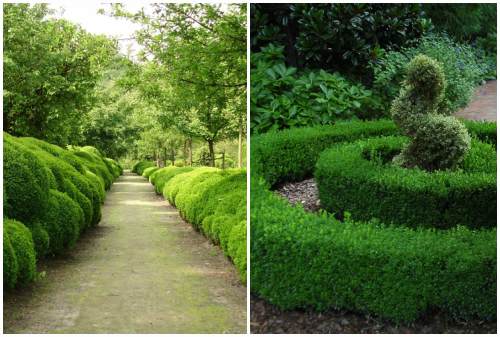

Buxus is cultivated in the open air, using it in many ways: hedges and hedges, green figures, single decorative plantings. Potted specimens become a real decoration of balconies and terraces, without problems transferring the conditions of the city.
How to plant boxwood
- Boxwood is planted in open ground in the fall (September-October), or in the spring, at the end of the dormant period (March-April).


- The bush is not picky about the composition of the soil. During planting, it is recommended to add humus, about 5 kg per square meter.
- The seedlings are hard to tolerate the transplant, so it should be as gentle as possible. The night before, the earthen lump is watered abundantly so that it is easily shaken out during transplantation.
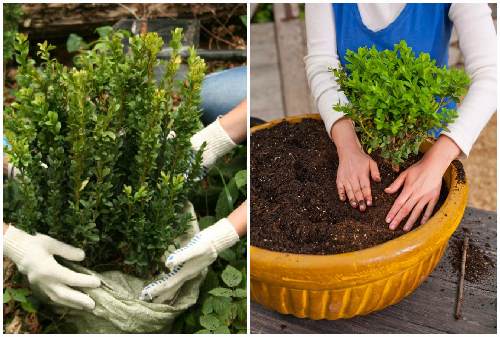

- When forming hedges, boxwood seedlings are placed at a distance of 50 cm between the bushes. The trunk circle is mulched with peat.
- Further care in the open field is ensured by regular watering, if necessary, by decorative pruning. In winter, he needs shelter, and in spring, protection from the first hot rays, which can cause burning of foliage.
Lighting
When choosing a site for planting, pay attention to the illumination, since the plant does not like direct sunlight. Light shading will be preferred.
Features of boxwood (video)
Boxwood (buskus) - several dozen species of evergreen shrubs, characterized by the presence of a large number of shoots with rather dense dark green shiny leaves. Decorative boxwood is widely used in landscape design to create curbs, hedges, curtains. Considering that the plant perfectly tolerates pruning, geometric shapes and complex plot compositions are created from boxwood bushes in the plots.
Growing boxwood at home
Boxwood is often grown as a houseplant.Due to its small leaves and rather slow growth, boxwood is popular among flower growers who are fond of bonsai - growing dwarf trees. The Garland species is best suited for creating a bonsai from boxwood, which lends itself to any method of formation: pruning, shearing, reshaping with the help of wire frames.
Indoor boxwood: care
When grown at home, the following types of boxwood are popular:, bolear and small-leaved, perfectly adapting to the small space of the pots. As an indoor culture, boxwood is capricious: it reacts to improper care by dropping foliage.
When organizing boxwood care at home, you should adhere to the following requirements:
- the place where the plant is kept should be well lit, but boxwood does not tolerate direct rays of the sun;
- a moderate temperature is favorable for a houseplant, in winter boxwood needs coolness (temperature + 6 ... + 10 degrees);
- in the warm season, abundant watering and daily spraying with water at room temperature is recommended. In the autumn-winter period, the amount of watering is reduced, since the roots do not tolerate waterlogging poorly;
- in spring and summer, the plant needs regular feeding (once every 10 - 12 days). It is advisable to alternate the application of organic and mineral fertilizers. For feeding, complexes designed for azaleas are suitable;
- pruning of indoor boxwood may not be carried out throughout the year as needed;
- boxwood transplantation is carried out annually. The new container should not be too spacious, as the plant will stagnate.
Attention! Boxwood bonsai do not need replanting, as the formed shoots can be damaged.
Boxwood: reproduction
An ornamental plant propagates by seeds and cuttings, but cuttings are most often used. A thick drainage layer is made in the pot, a soil mixture is prepared from leafy earth (2 parts), coniferous soil (1 part), coarse sand (1 part). In August - September, lignified cuttings 7 - 9 cm long with two internodes are cut. Cuttings take root for a very long time, to speed up the process, soil heating and phytohormones are used.
Boxwood: diseases
As already noted, the loss of decorative qualities is caused by improper care of a houseplant. Excessive watering in winter causes rotting of the root system; dry air, irregular spraying in heat - curling and drying of foliage; too warm room temperature in winter - shedding of leaves. A gall midge, or scale insect, can settle on a weakened plant. To destroy pests, experienced flower growers recommend pruning diseased shoots and treating boxwood with fungicides, and subsequently adjusting the care.
It is very useful to keep boxwood indoors, since the representative of myrtle releases phytoncides that neutralize harmful bacteria. In this regard, the microclimate in the room where the plant is located improves.
March madness - this is how those who grow seedlings of their favorite vegetables themselves perceive the first calendar month of spring. In March, they sow their favorite tomatoes and peppers, carry out the first crops in the greenhouse and even sow vegetables in the beds. Growing seedlings require not only a timely dive, but also a lot of care. But only her troubles are not limited. It is worth continuing sowing in greenhouses and on window sills, because fresh greens from the beds will not appear so soon.
In the month of March, most of the flowering annuals are sown, which need a seedling method of growing. Usually, these flowers take no more than 80-90 days from germination to flowering. In this article, I would like to focus on interesting annuals, which are slightly less popular than the ageless petunias, marigolds or zinnias, but they have no less advantages. And they are also worth trying to plant for flowering in the coming season.
With the approach of spring, indoor plants gradually come out of dormancy and start growing. Indeed, already in February, the day becomes noticeably longer, and the sun warms up completely in spring. How to help flowers wake up and prepare them for the growing season? What should you pay attention to and what measures should be taken so that the plants are healthy, bloom, multiply and please? We will talk about what houseplants expect from us in the spring in this article.
One of the most important rules for growing strong and healthy seedlings is the presence of the "correct" soil mixture. Usually, gardeners use two options for growing seedlings: either a purchased soil mixture, or made independently from several components. In both cases, the fertility of the soil for seedlings is, to put it mildly, doubtful. This means that the seedlings will require additional nutrition from you. In this article, we will tell you about simple and effective feeding for seedlings.
After a decade of dominating the catalogs of original variegated and vibrant tulips, trends began to change. At exhibitions, the world's best designers offer to remember the classics and pay tribute to the charming white tulips. Glittering under the warm rays of the spring sun, they look especially festive in the garden. Meeting spring after a long wait, tulips seem to remind that white is not only the color of snow, but also a joyful celebration of flowering.
A sweet Indian pumpkin chutney sauce with lemon and orange, native to India, however, the British have contributed to its popularity around the world. This sweet and sour vegetable and fruit seasoning can be eaten straight away or prepared for future use. For storage, use fruit or wine 5% vinegar. Aging chutney for 1-2 months will soften the flavor and be more balanced. You will need butternut squash, ginger, sweet orange, juicy lemon, and spices.
Despite the fact that cabbage is one of the most popular vegetables, not all summer residents, especially beginners, can grow its seedlings. In the conditions of the apartment, they are hot and dark. In this case, it is impossible to get high-quality seedlings. And without strong, healthy seedlings, it is difficult to expect a good harvest. Experienced gardeners know that it is better to sow cabbage for seedlings in hotbeds or greenhouses. And some even grow cabbage by direct sowing of seeds into the ground.
Florists tirelessly discover new indoor plants for themselves, replacing some with others. And here the conditions of a particular room are of no small importance, because the requirements for their content in plants are different. Lovers of beautifully flowering plants often face difficulties. Indeed, in order for flowering to be long and abundant, such specimens require special care. There are not very many unpretentious plants blooming in rooms, and one of these is streptocarpus.
Chicken rolls "Cordon Blue" with béchamel sauce are an excellent dish for a festive table and daily meal! It is prepared simply and quickly, it turns out juicy, and also a thick bechamel sauce - you will lick your fingers! Mashed potatoes, pickled cucumbers and a slice of fresh bread will make a hearty and delicious dinner. Choose cheese for this recipe according to your taste, it can be processed, or with blue mold. It is important that the cheese and ham are sliced very thinly, this is the secret of success!
Calendula (marigold) is a flower that stands out among others for its bright color. Low bushes with delicate orange blossoms can be found on the side of the road, in the meadow, in the front garden next to the house, or even in the vegetable beds. Calendula is so widespread in our area that it seems that it has always grown here. Read about interesting decorative varieties of calendula, as well as the use of calendula in cooking and medicine, in our article.
I think many will agree that we perceive the wind well only in a romantic aspect: we are sitting in a cozy warm house, and the wind is raging outside the window ... In fact, the wind blowing in our areas is a problem and there is nothing good in it. By creating windbreaks with plants, we break the strong wind into several weak streams and significantly weaken its destructive force. How to protect the site from the wind will be discussed in this article.
Making a shrimp and avocado sandwich for breakfast or dinner is as easy as shelling pears! Such a breakfast contains almost all the necessary products that will recharge you with energy so that you will not want to eat before lunch, while extra centimeters will not appear on the waist. This is the tastiest and lightest sandwich after perhaps the classic cucumber sandwich. This breakfast contains almost all the necessary foodstuffs that will recharge you with energy so that you will not want to eat before lunch.
Modern ferns are those rare plants of antiquity, which, despite the past time and all kinds of cataclysms, not only survived, but in many respects were able to retain their former appearance. In the indoor format, of course, it is not possible to grow any of the ferns, but some species have successfully adapted to life indoors. They look great as single plants or adorn a group of decorative deciduous flowers.
Pilaf with pumpkin and meat is Azerbaijani pilaf, which differs from the traditional oriental pilaf in the way of cooking. All ingredients for this recipe are prepared separately. Rice is boiled with ghee, saffron and turmeric. The meat is fried separately until golden brown, pumpkin slices as well. Onions and carrots are prepared separately. Then everything is laid in layers in a cauldron or a thick-walled pan, pour in a little water or broth and simmer over low heat for about half an hour.
Boxwood is an evergreen plant that grows in the form of a shrub or tree. For a long time, cute bushes with small foliage have been used to decorate both garden and park areas and dwellings. Today boxwood, due to its good tolerance for pruning, is often used not only in single plantings, but also for zoning the garden in group plantings as borders.
Varieties and types
Mainly grown as a tree, rarely seen as a shrub. The stems are abundantly covered with shiny matte foliage. Inflorescences are light green. Quite painful for frost. The following varieties are derived from this species: suffruticosis
,
Blauer Heinz
,
Elegans
other.
This species withstands temperature drops better than evergreen buxus. We grow varieties Faulkner
and
Winter Jam
.
A species that grows very slowly and can withstand very low temperatures, and also has a long lifespan.
The plant has rather large foliage, grows quickly, but does not tolerate frost.
Trees and zones of the Earth
When choosing a site for building a house, a garden or any other purpose, pay attention to the nature and type of plants growing in the area, from them you can often guess whether this place is good for a person or not. If in front of you is a grove of aspens, elms or other trees - vampires, then most likely the place itself is not suitable for buildings (even if you cut down all the trees, the energy will remain negative). It is also not good if there are many frail, sick, twisted trees on the site, even if they belong to donors.
Using the services of a specialist or on your own, you can determine where and which zones of the Earth are located in your home, as well as throughout your entire site. This is usually done using frames or a pendulum. If there are places of energy release (positive or negative) on the site, plant donor trees there, such as cedar, oak, birch, pine, mountain ash or apple tree.Such trees transform negative energy and harmonize the energy of the area as a whole.
In folk medicine
No wonder it sounds, but poisonous boxwood has been used since ancient times and is still used in healing. If in ancient times it was used to treat coughs, gastrointestinal diseases, chronic fevers, such as malaria.
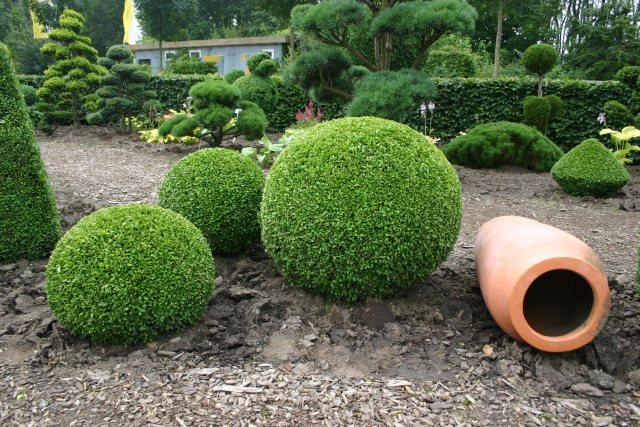

Now this toxic drug is handled very carefully. Modern homeopaths use boxwood as a remedy for rheumatism, for external use.
List of plants to be treated with caution
There are a number of indoor flowers that can harm the human body only if they are incorrectly positioned in the house. In addition, some plant species cause allergies or mild ailments. The list of these plants is as follows:
- Lily (Lilium).
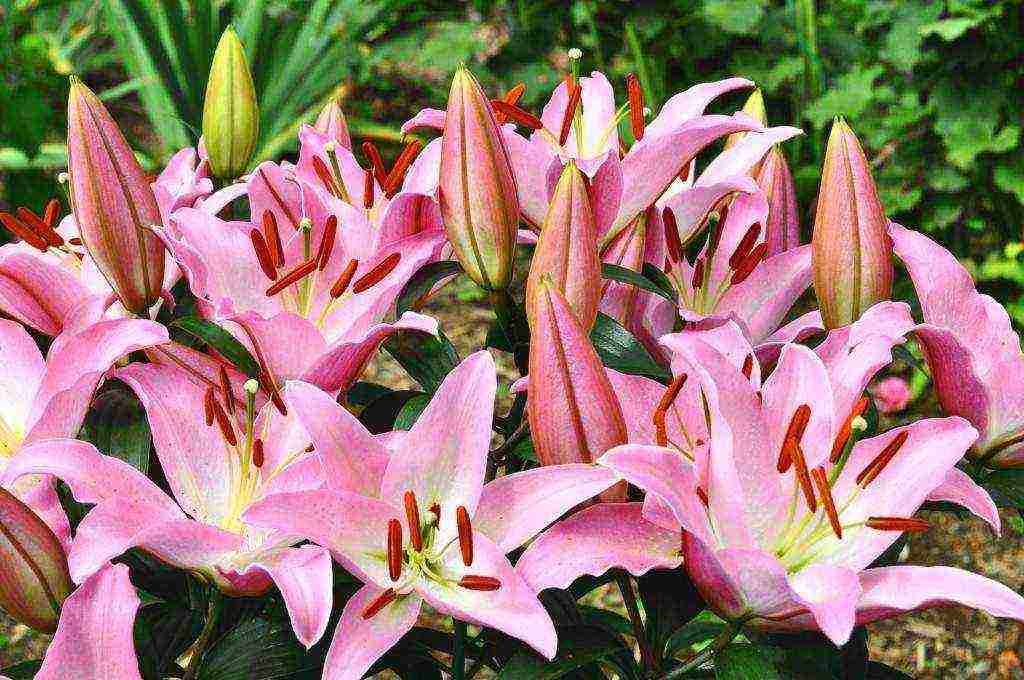

A flower loved by many with a tart aroma. It is because of this concentrated smell that they are not recommended to be kept in the bedroom, as they can cause insomnia. At night, lilies emit a lot of carbon dioxide, so in the morning you can wake up with a headache and tired. - Ficus.
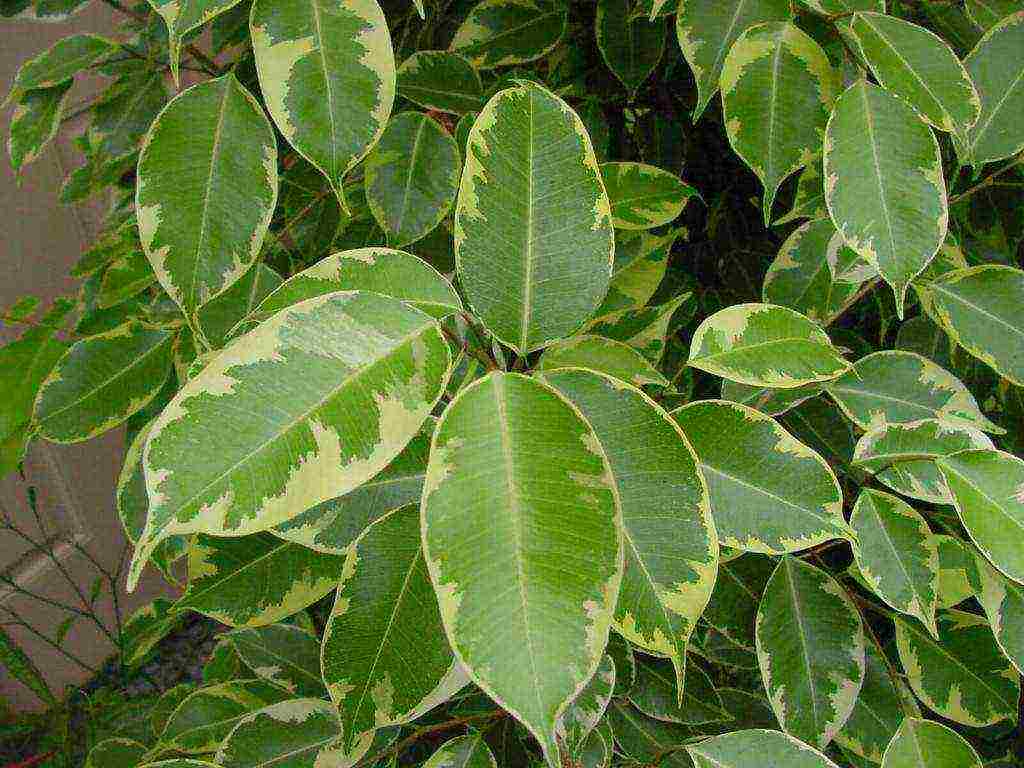

A lush green plant with oblong leaves. Ficus is not very dangerous for humans, but it is capable of causing allergic reactions more than others. - Orchid (Orchidaceae).
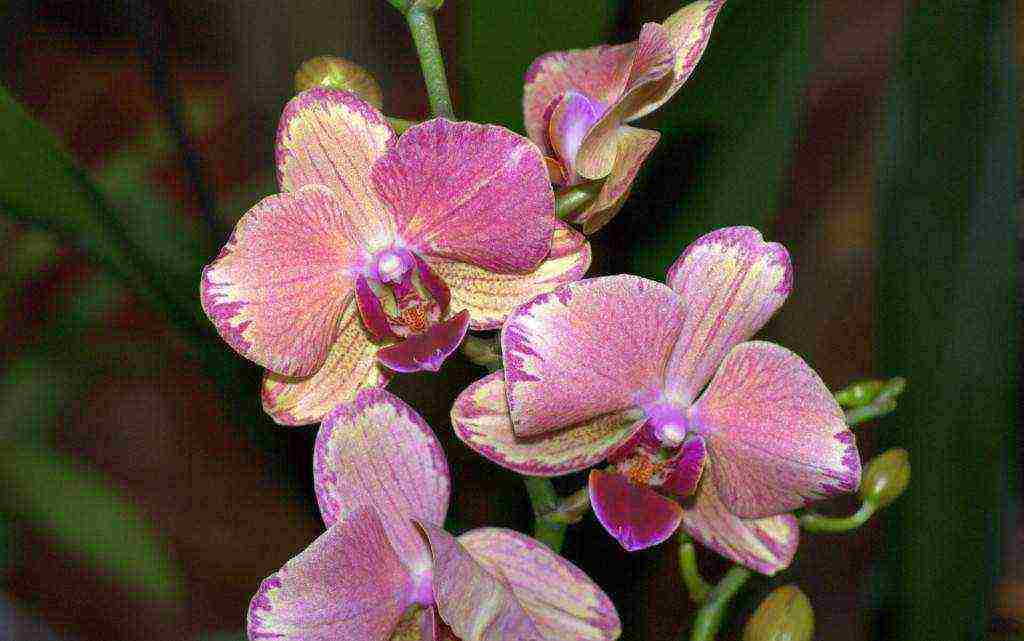

A beautiful plant with unusual flowering of various shapes and colors. It is better to place such a flower next to the workplace for the reason that it excites the nervous system. If you put an orchid in the bedroom, then it will lead to sleep disturbance.
We have a whole section on the site dedicated to orchids. See if you can find a plant that suits you, they have beautiful flowers! - Fern (Polypodiophyta). Its action is similar to that of a lily. Fern gives off carbon dioxide at night, which leads to headaches in the morning.
- Hydrangea (Hydrangea).
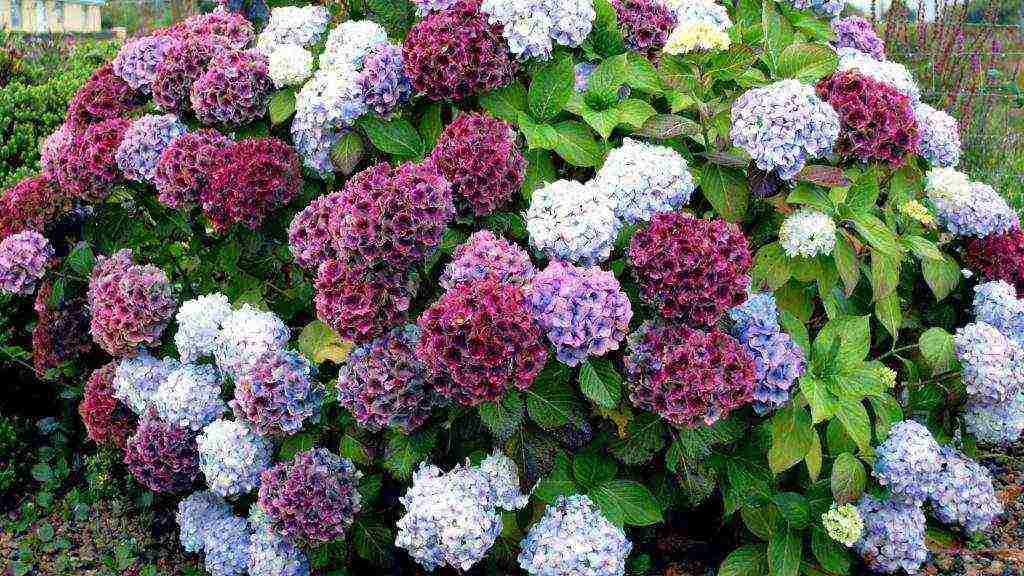

A flower that strikes with its inflorescence with a large number of small flowers forming a "cap". The color is varied from pink to blue shades. Hydrangea gives off particles that can cause allergies. - Tuberose (Polianthes tuberosa).
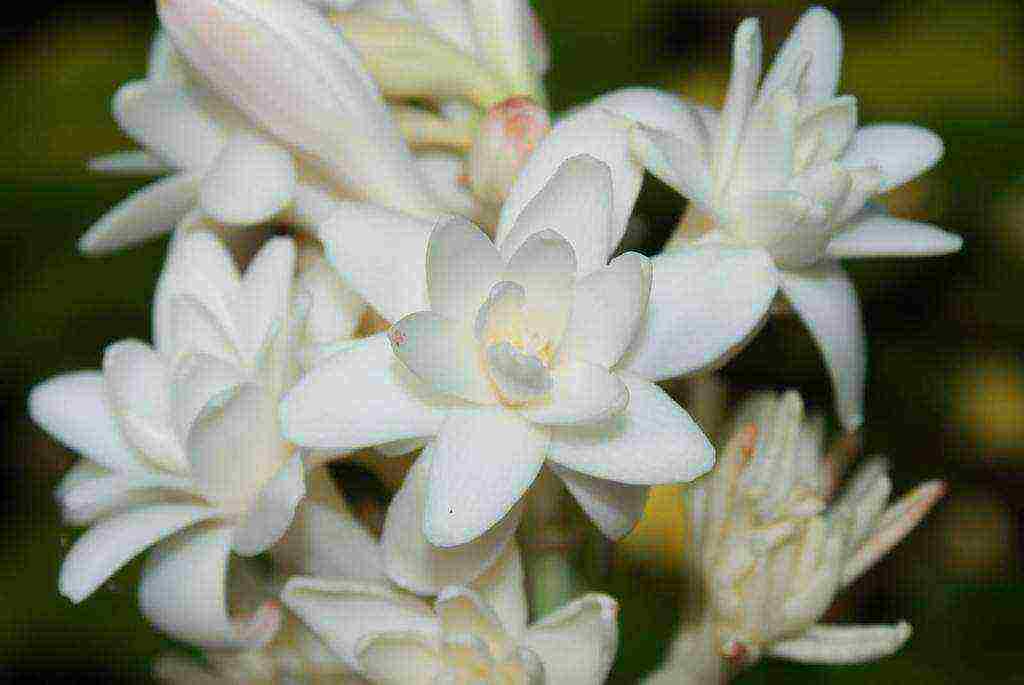

It is a perennial plant with a stem 45 cm high, white flowers form at the top. It has a very sweet and strong aroma. The plant secretes particles that greatly exacerbate the sense of smell. It is not recommended to keep such a flower for people with heart disease and hypertension. With such diseases, the scent of a flower can cause dizziness and mood loss, up to depressive states.
All flowers with a strong aroma should be placed in a well-ventilated area. Then there will be no problems with feeling unwell.
The use of boxwood wood
Boxwood is used for the manufacture of small-sized dishes, chess pieces, musical instruments, measuring instruments, parts of optical and surgical instruments, as well as smoking pipes.
Boxwood is ideal for woodcutting. That is why boxwood was massively destroyed in the 19th century, when illustrations in newspapers were carved on boxwood boards.
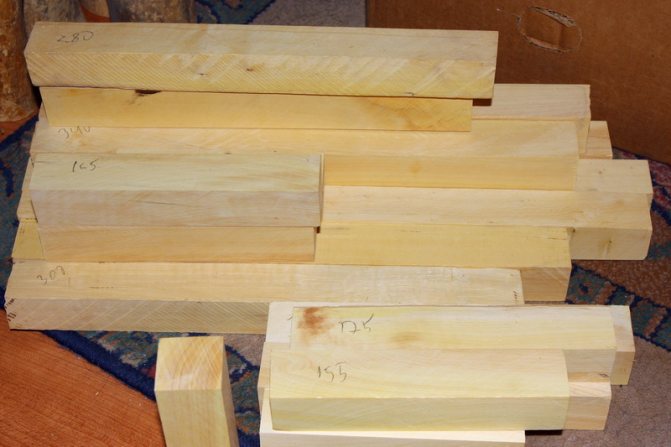

In modern Japan, figurines for playing shogi are made from boxwood.
Boxwood and its role in landscaping your home
The life of a modern person mainly takes place among urban concrete landscapes, surrounded by dead objects and mechanisms. Therefore, it is not surprising that a person experiences an acute need to introduce elements of living nature into the surrounding space. This is clearly expressed in contemporary interior and exterior art. Many designers consider live plants to be the best decoration for homes and areas adjacent to the home. For a long time, business is not limited to flowers in ceramic pots or traditional flower beds.Living green is becoming a material in designer fantasies, taking on amazing forms - from exquisite borders, hedges, picturesque parterres, green arches and gazebos to topiary sculptures. Boxwood is one of the favorite plants for parks and courtyards, winter gardens and apartments.
What trees can not be planted on the site
It should be remembered that not all trees and large shrubs are recommended to be planted near the house.
It is believed that planting an oak on the site is a very bad omen, foreshadowing the death of the head of the family. In addition, the aura of this tree perceives only healthy and physically strong people. But even they are not recommended to plant an oak in their area, because energy can be destructive for household members.
Birch is a very powerful protective agent. But she must grow behind the fence of the house, near the gate, and next to the birch you can put a bench to communicate with this tree. Then she will not let evil into the house. When asked whether it is possible to plant a birch near the house, the signs are answered by the fact that spirits live in its crowns, and they are far from always kind to people.
The walnut can be planted on the site, but far from the house and outbuildings. It's not only about the signs, but also about its branched root system, which can damage the foundation.
There is a belief that whoever plants a willow dies in the same year. Moreover, you cannot plant a willow in honor of the birth of a child. There is also a belief that aspen and willow bring death and grief. You should not tempt fate, it is better to choose other trees for the site.
Poplar is planted away from home. It perfectly removes negative energy. But being too close to the dwelling, its powerful root system can damage the building, and a huge trunk that has fallen due to a storm will become a real disaster.
The pine tree can take away your crops and destroy all the plants nearby. But here it's not so much about magic, but about the fact that the pine tree has its own characteristics, and you need to place it wisely. The crown shades the area, and the needles do not provide useful humus. Anyone who has been to a pine forest knows that the soil there is sandy. The energy of this tree is quite positive.


What about the decorative thuja in the yard? Signs say that girls living in the house will not marry if thuja grows on the site. In many cultures, this tree of sorrow and sorrow is often planted in cemeteries. On the other hand, it is generally accepted that the smell of thuja drives away evil spirits.
Summing up, we can say: most plants have a positive energy, with rare exceptions. But if a certain tree evokes negative associations in you, it is certainly not worth planting.
List of poisonous plants
This group of plants includes those species that should not be kept at home, especially in the presence of animals or children due to extremely dangerous properties. A child, like a pet, is capable of poisoning with similar flowers or getting burns if handled carelessly.
If there are no children and animals in the house, then take precautions when caring for such plants. Be sure to wear gloves when handling these colors and rinse tools thoroughly. Do not under any circumstances cut these flowers with a knife intended for food in your kitchen.
Consider this group of plants:
- Dieffenbachia (Dieffenbachia).
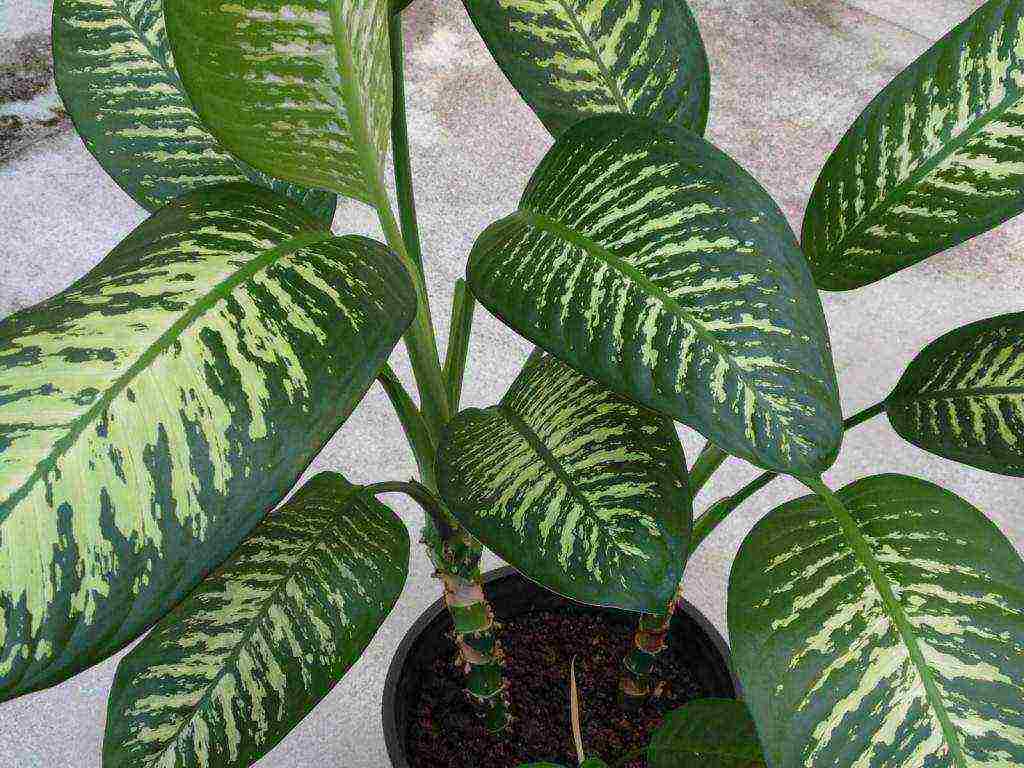

A popular indoor plant that attracts flower growers with huge yellow-green leaves that form a fluffy crown. The flower is dangerous for its sap, which is released when the leaves or stem are cut. If a pet or a child decides to chew any part of this flower, then the juice that gets into the body will cause severe poisoning. In addition, dieffenbachia juice causes burns and irritation to the skin. - Oleander (Nerium oleander).
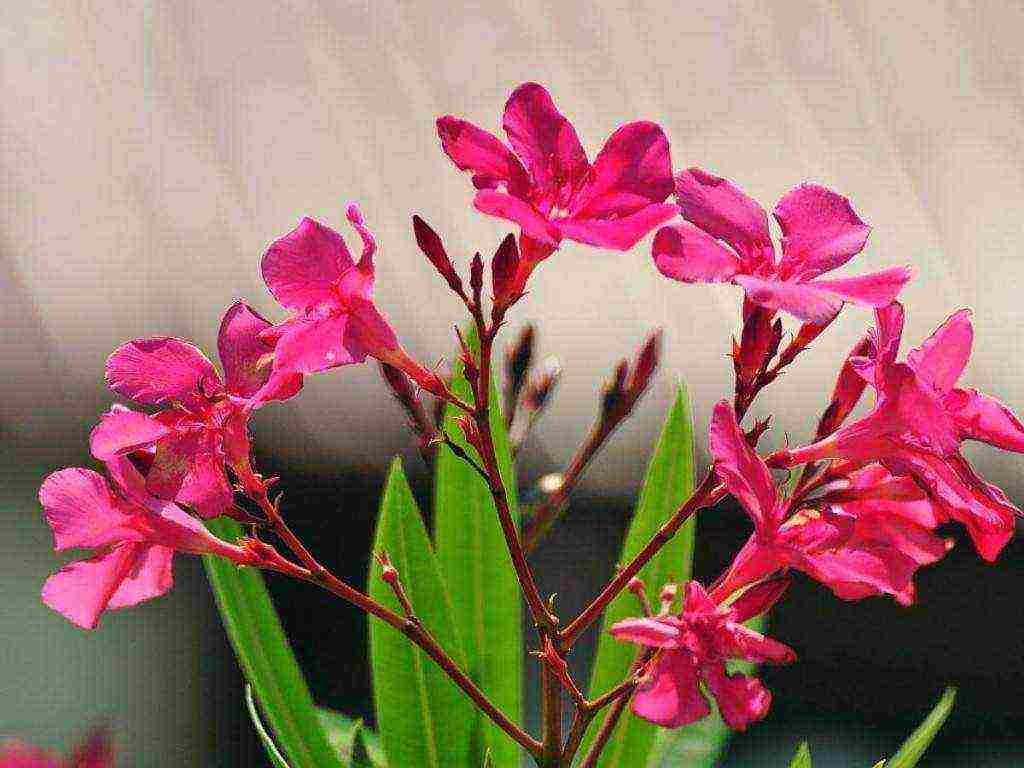

Popular for its bright crimson flowers. The ingestion of oleander juice into the body causes blindness.The scent of a flowering plant contributes to dizziness and feeling unwell. - Euphorbia (Euphorbia).
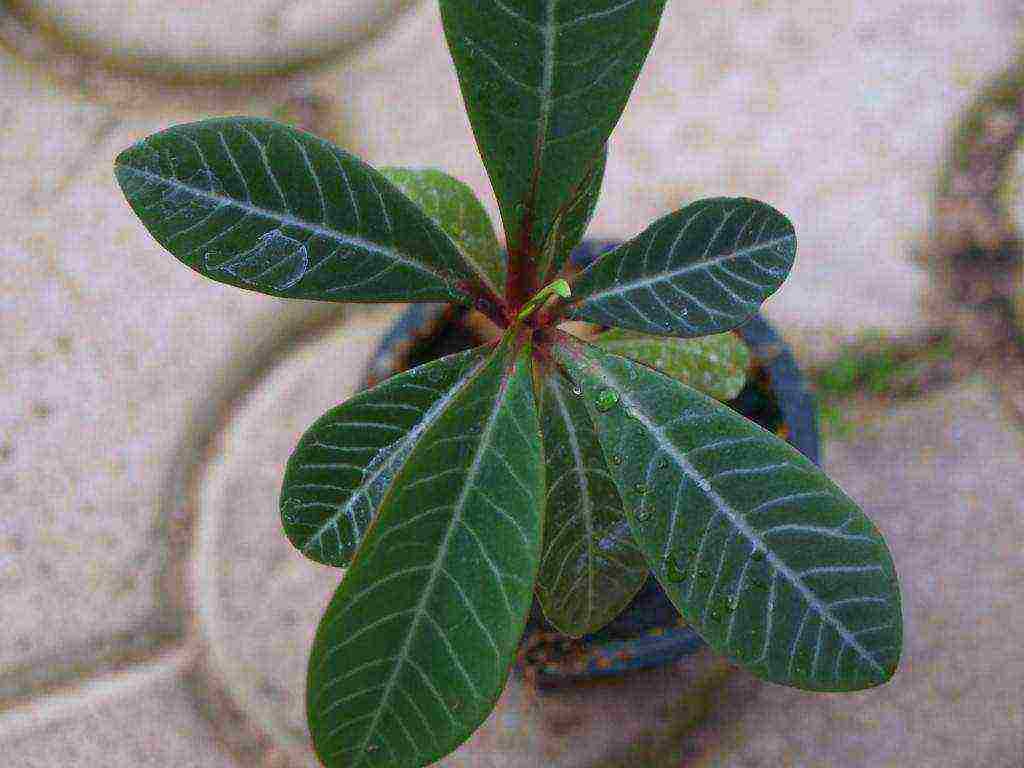

This plant is represented by a huge number of species and various forms, therefore, it cannot be described unequivocally. Many representatives are similar in appearance to cacti and have thorns, the prick of which is also dangerous for a living organism. Euphorbia contains white sap in its stem and leaves, which causes burns and irritation to the skin. When ingested, it causes poisoning.
By the way, on our website there is a large article about caring for this plant, so we recommend that you read it! - Croton.
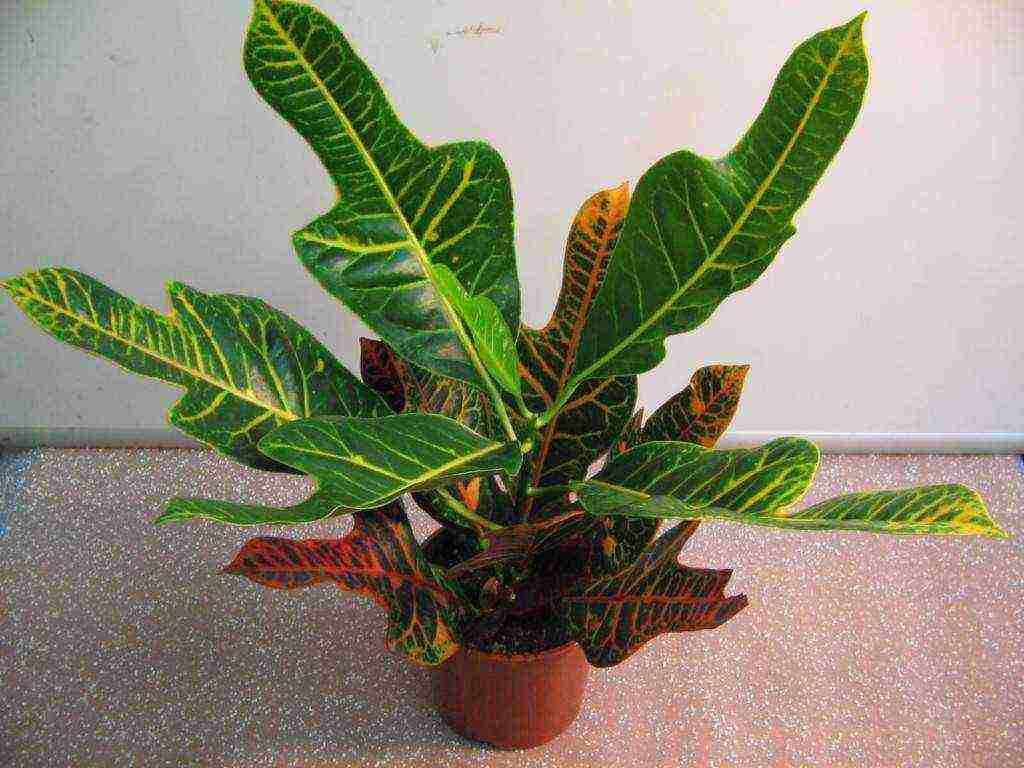

If we talk about this plant, which belongs to the euphorbia family, then it looks like a small tree with variegated leaves that have an elongated shape. Its flowers are inconspicuous, and it rarely blooms at home. The sap of this plant causes burns on the skin. If the juice gets into the bloodstream when cut or ingested, then the case may end in death or resuscitation. - Azalea (Azalea).
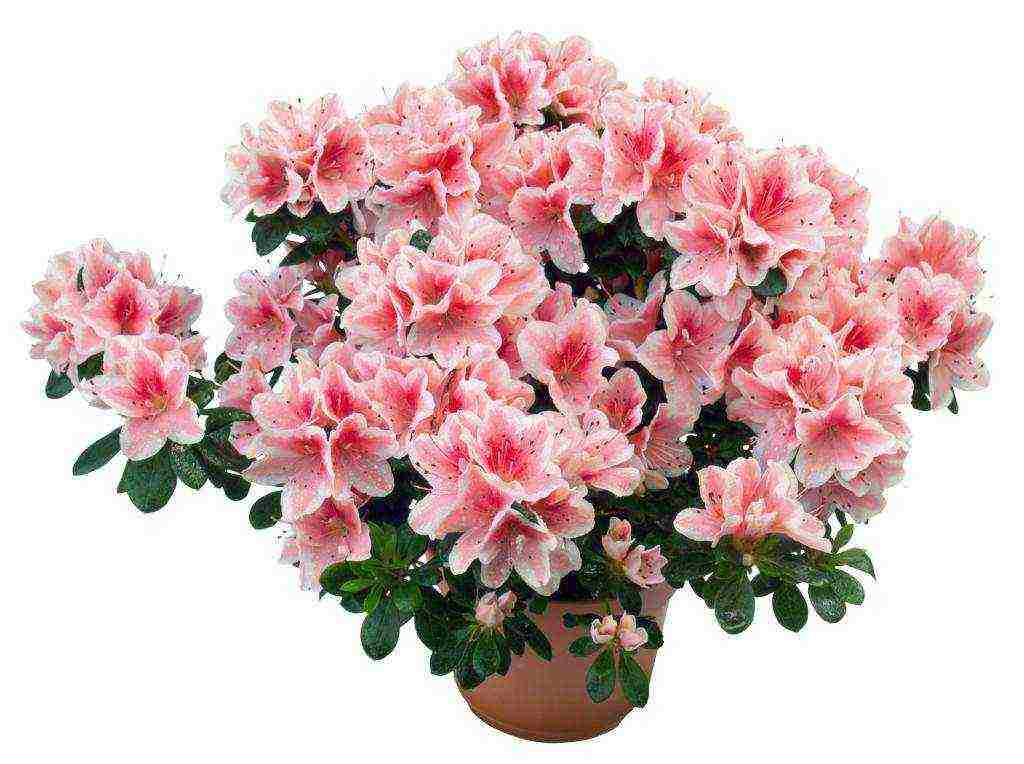

A common plant among flower lovers. It is famous for its lush and attractive flowering. The colors are very diverse: white, pink, red, yellow in azalea flowers. Azalea Simsa (Indian Azalea) is considered dangerous. Ingestion of the leaves of this flower causes intestinal colic and cramps. - Mimosa bashful (Mimosa pudica).
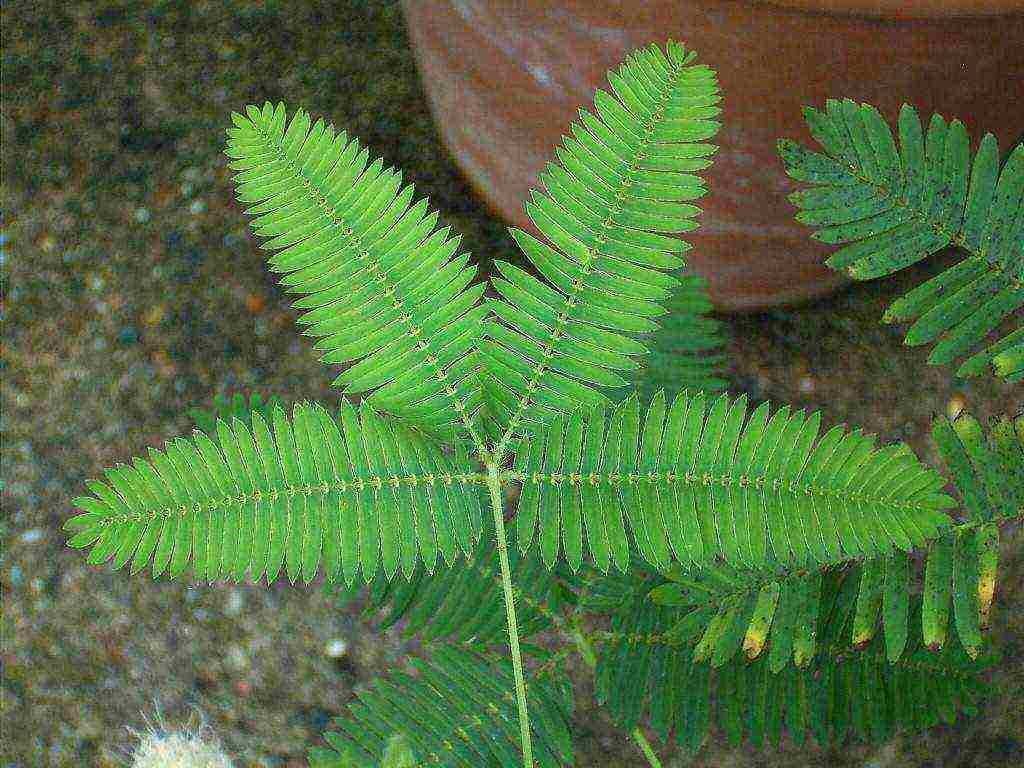

A bizarre plant that externally is represented by thin stems and small leaves. The leaves look fragile and delicate, and upon contact with an object, they curl up into a tube. Long-term human contact with these flowers leads to hair loss and loss. Sometimes it comes to complete baldness. The fact is that this plant emits harmful and toxic substances that poison the human body. - Evergreen ivy (Hedera).
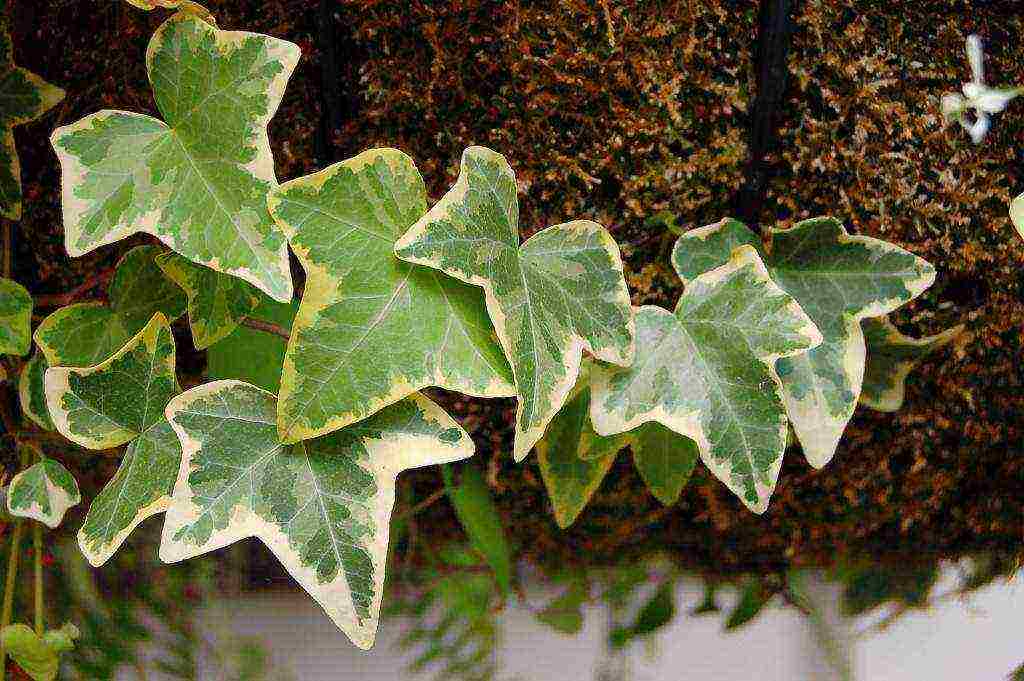

This plant belongs to the Araliaceae family. It is a shrub in the form of vines. Cats are very attracted to the bright green color of the leaves of this plant, but in ivy, the leaves and berries are poisonous, so the animal can die or be severely poisoned. - Adenium (Adenium).
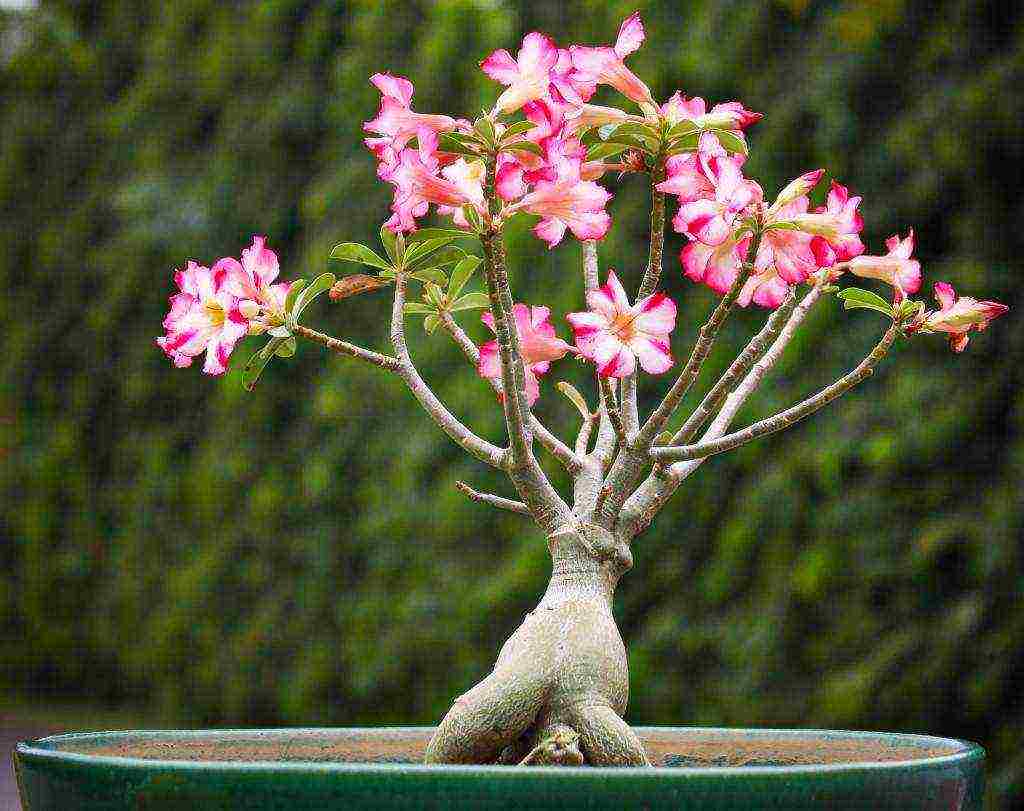

A very beautiful plant, which is represented by a thick, obese stem in the form of a small tree trunk. At the top are sparse leaves and a large number of medium-sized pink flowers. The plant is very toxic, adenium juice is especially dangerous. On contact with the body, it causes poisoning and burns. - Monstera.
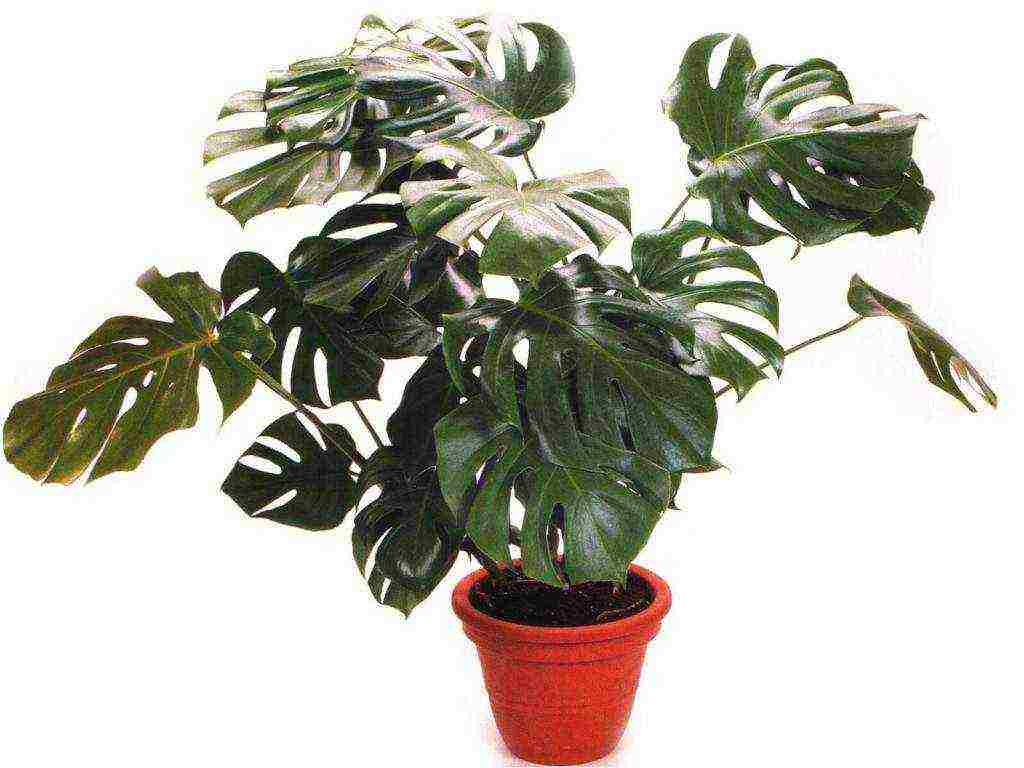

Monsterra is not a very dangerous plant, but still it is better not to start it at home.
A spectacular plant with huge leaves and growing to an impressive size. Usually, monstera can be found in public places or botanical gardens. Monstera juice can cause burns on the skin, upset the digestive system, and if it gets into the eyes, damage them.
- Philodendron
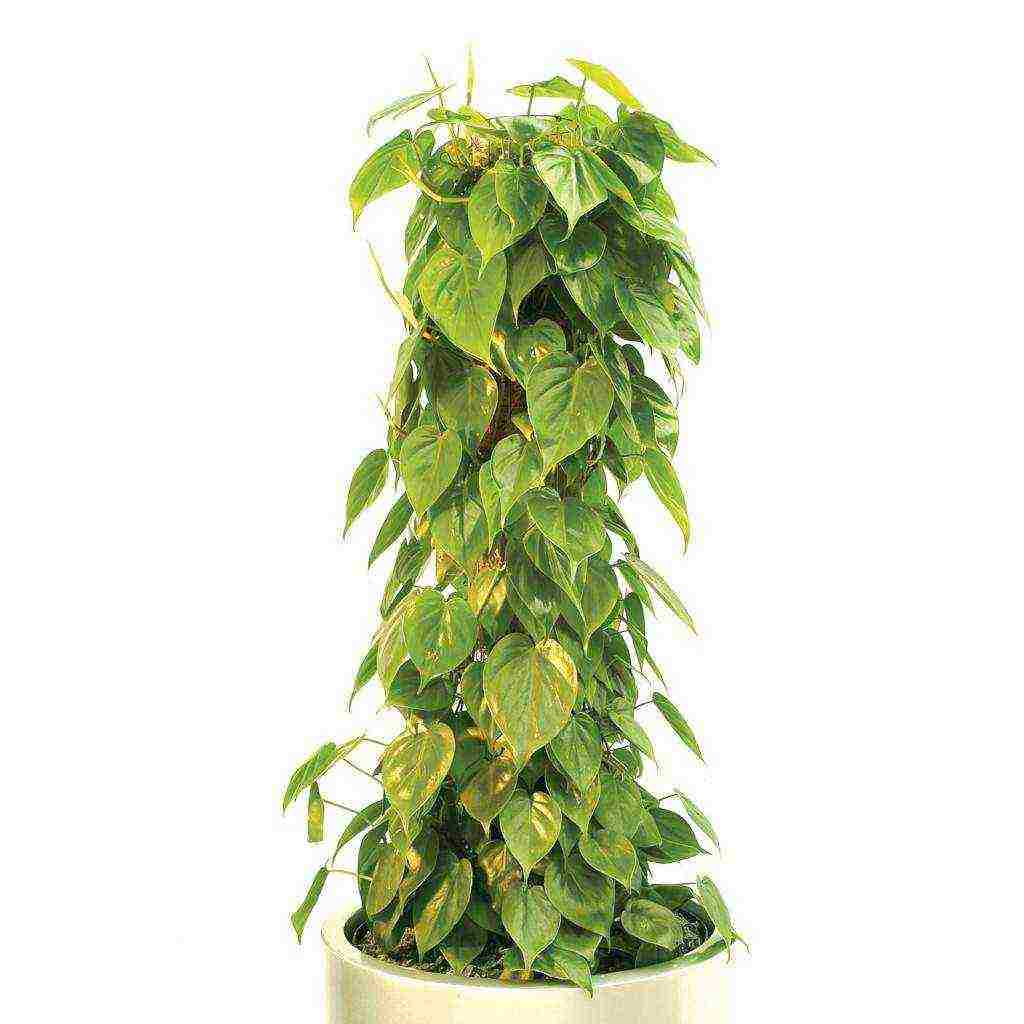

Belongs to the aroid family. The plant is represented by bushes, vines and lush greenery. Philodendron juice is poisonous. Contact with skin and eyes causes irritation and burns. - Primula (Primula).
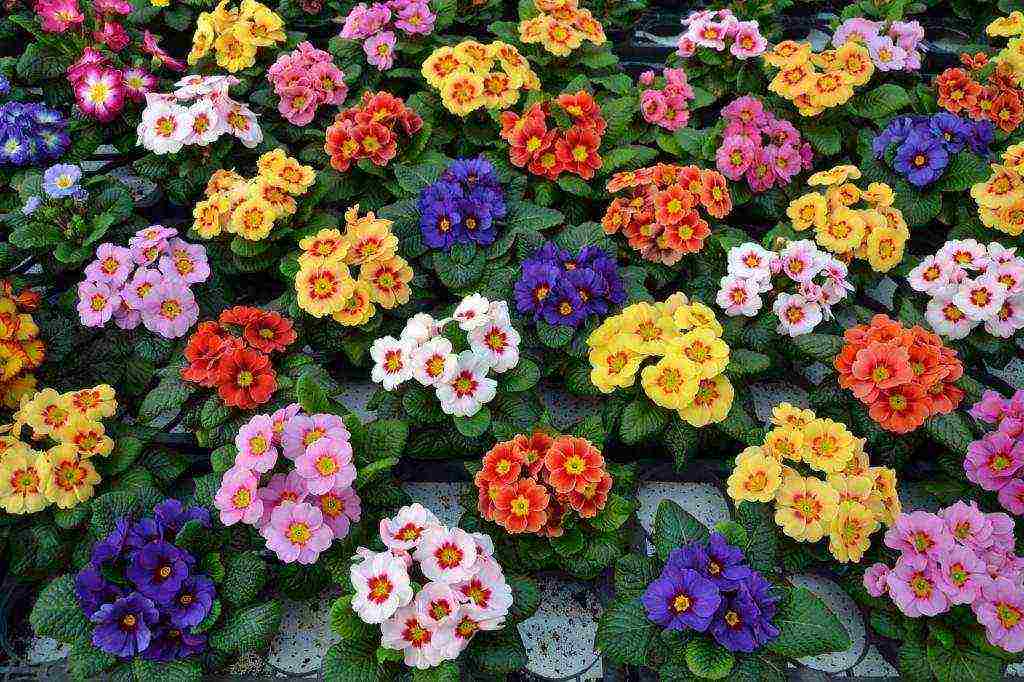

The flower has gained such popularity due to the beautiful flowering of various shades, small size and velvety leaves. During flowering, the plant releases toxic substances that cause nausea and dizziness. The velvety leaves are covered with small villi, contact with which leads to burning sensation and allergies. - Stellera dwarf (Stellera chamaejasme).
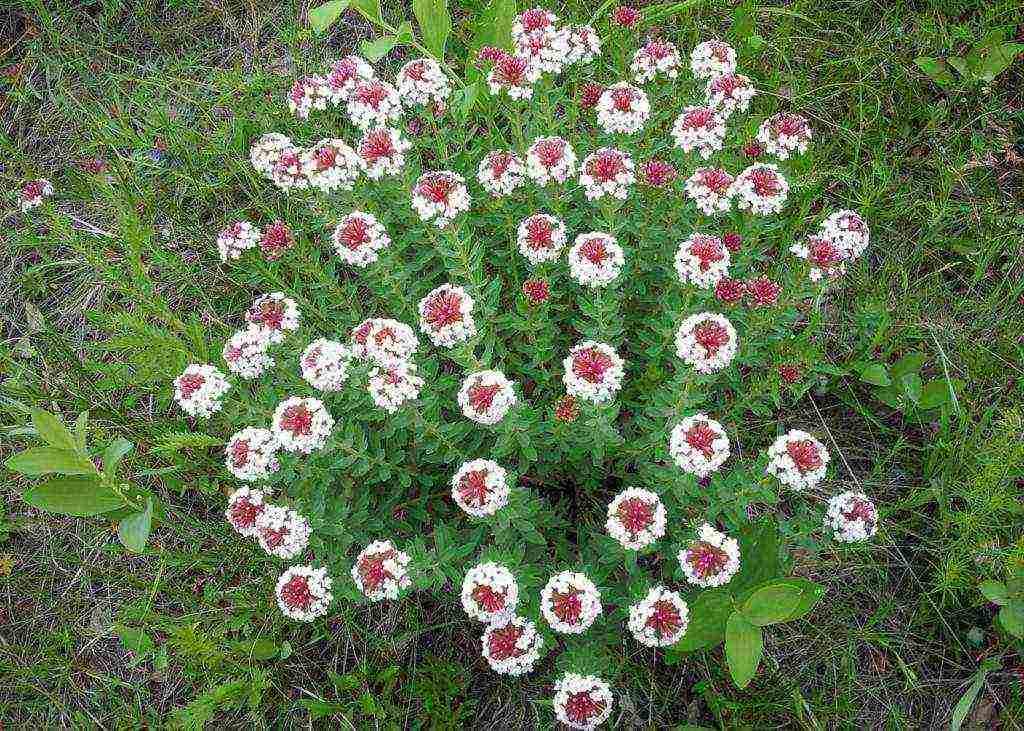

In the photo of Steller in natural habitat. This plant is known for its medicinal properties, but it can only be used for such purposes under the supervision of a doctor. The flower itself has a high stem on which the inflorescences are located. They consist of 20-30 small white flowers. The ingestion of the leaves of the plant in its raw form into the body leads to swelling of the vocal cords and even to numbness. - Nightshade (Solanum).
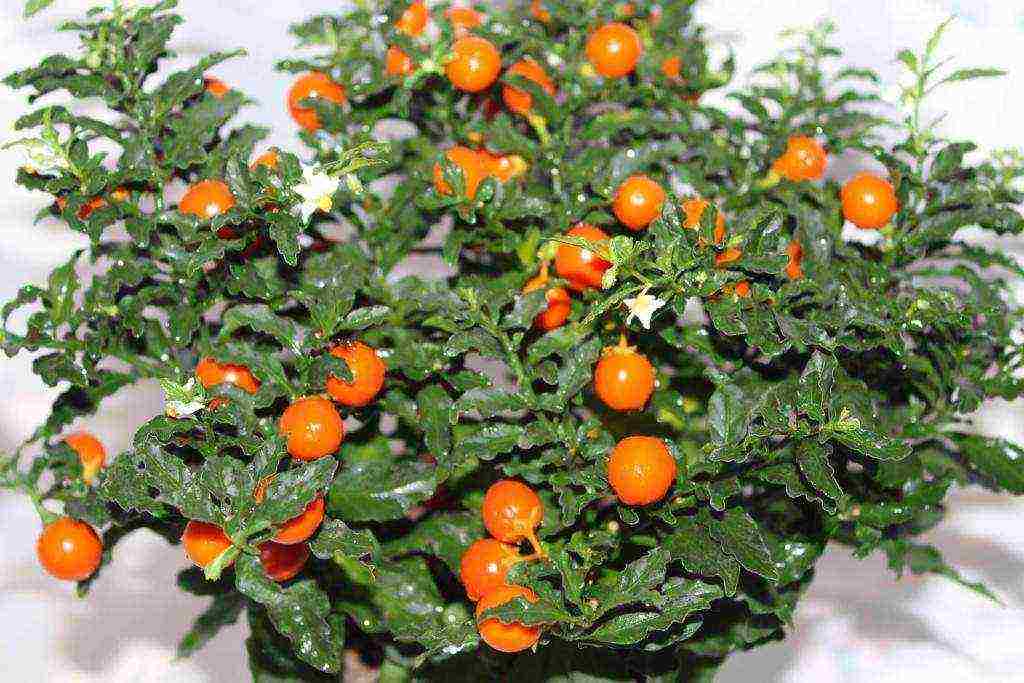

This flower attracts attention with its bright orange fruits that adorn the evergreen shrub. It is these fruits that are very poisonous and dangerous. May cause poisoning. The bright color of the berries attracts children and animals, so you should not keep such a flower at home. - Tulip Gesner (Tulipa gesneriana).
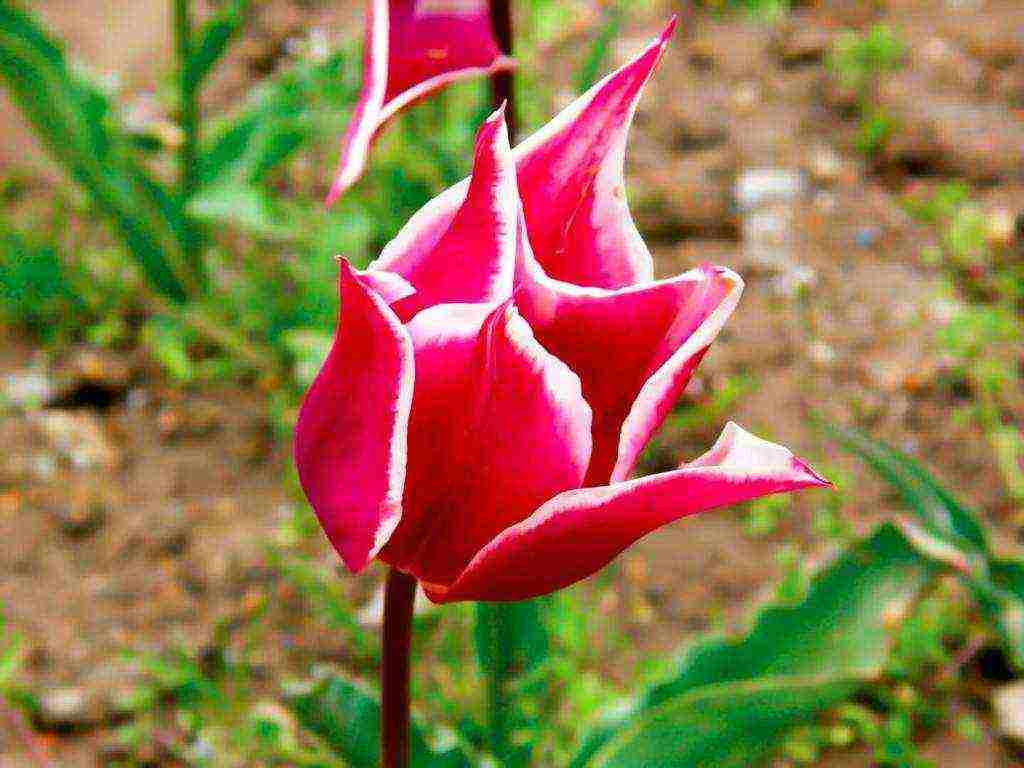

This plant blooms very impressively. It has a medium-sized stem on which a large flower is located. The color is varied - from yellow to red. But being with this flower for a long time indoors leads to hair loss and baldness. - Trichocereus (Trichocereus).
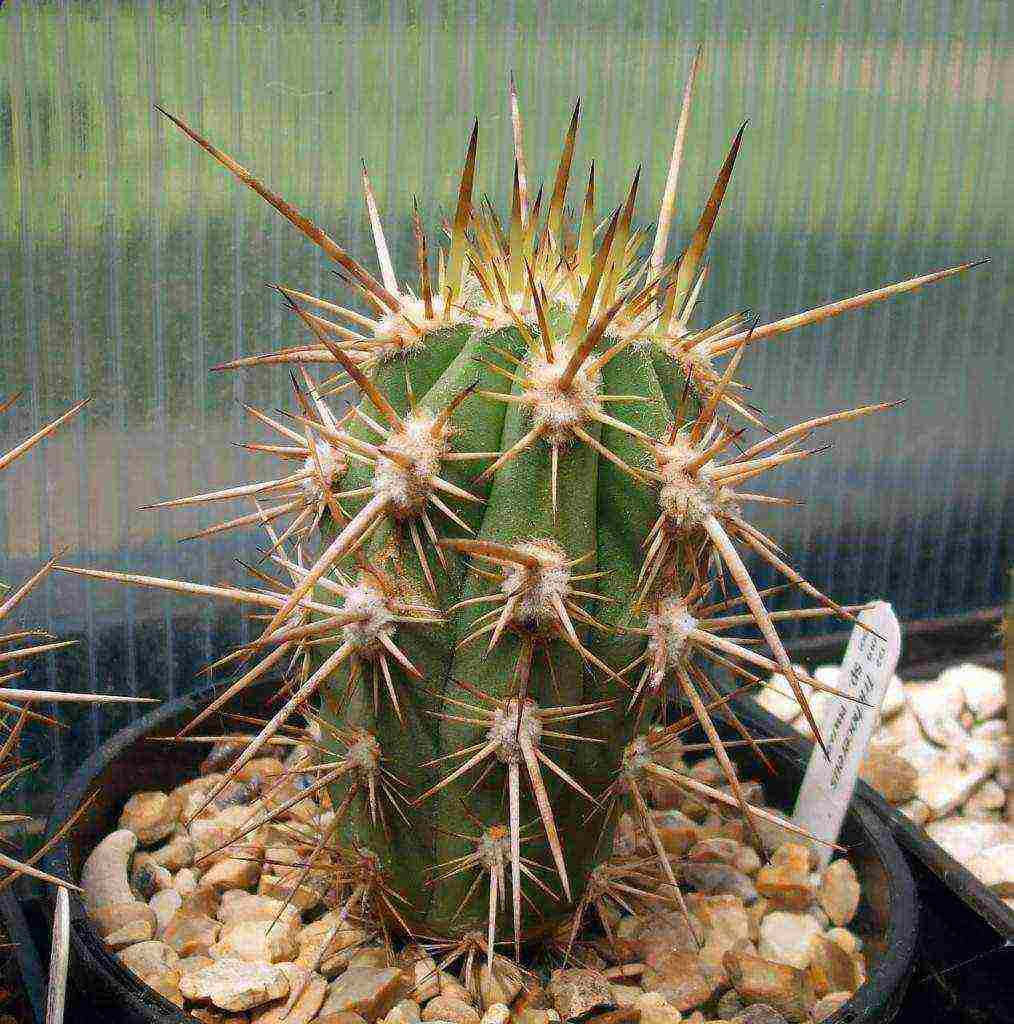

This plant is a species of cactus. It has long and large needles and blooms with large white flowers with a pleasant aroma. The plant contains hallucinogens and toxins that cause paralysis of the nervous system.
By families
The list of poisonous plants seems to be much longer, so when buying a flower, ask which family it belongs to. There are 4 main families of the most poisonous plants, namely:
- The euphorbia family. The juice of many members of this class is poisonous and causes burns on the skin.
- Aroid family. Most members of this group are toxic plants. Their juice is especially dangerous.
- Family of kurtovs. This class includes the most dangerous plants for human and animal life. They attract with their bright and variegated appearance. Wear gloves when working with this family of flowers.
- The nightshade family. In this class, far from all plants are poisonous, because the well-known potatoes and tomatoes belong to this family. But house flowers are most often toxic, and especially their fruits. Berries cause indigestion, nausea, vomiting.
Watch the video for details:
Sometimes indoor plants are not only beautiful, but also dangerous. For this reason, be sure to use protective equipment when working with flowers. If, in spite of everything, you decide to acquire such flowers, then try to protect them from possible contact with animals and children.
Boxwood care
This plant does not tolerate bright sun and freezing. As a result of the action of low temperatures and cold winds, boxwood may die. Therefore, take measures in advance to preserve the plant.
Boxwood seedlings can be insulated in different ways - it can be special nets, burlap, plywood boxes, spruce branches and so on. After the onset of warm spring weather, immediately remove the insulation, otherwise the plant will vomit.
During the summer season, mulch the soil with peat or humus, and water it constantly. In general, the soil surrounding the boxwood should always be moist. Spray the boxwood with an aerator to moisten the leaves. In the summer, be sure to plant organic or mineral fertilizers.
Before the onset of the winter cold, water the boxwood well, thereby giving the plant a supply of moisture. Then cover the soil near the box with peat or pine needles. Do not use fallen leaves for this purpose. Mow the plant several times a year to give it an aesthetic shape.
Types of boxwood with a photo
There are about 70 species of plants belonging to the genus Buxus.
Boxwood evergreen
It is a shrub densely covered with shiny dark green leaves. Greenish, fragrant flowers form an inflorescence - a brush.
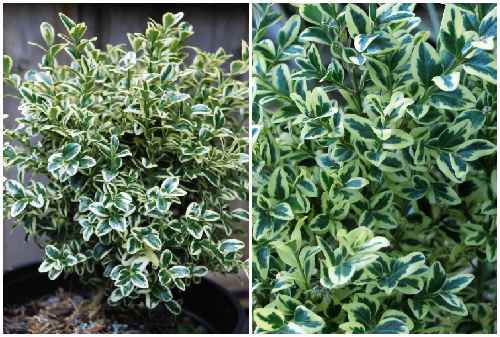

Decorative variety "Variegata", has a variegated color of leaves, with a white border. The trunk is short, with straight shoots. Due to its short stature, it is used for living curbs, ridges, flower beds.
Boxwood Colchis
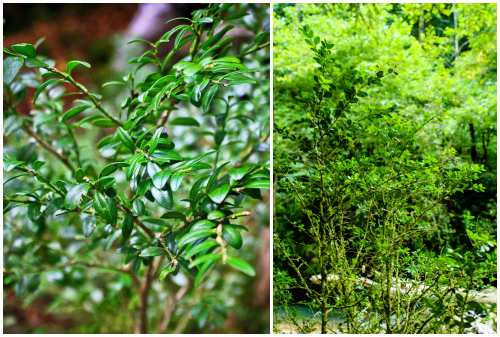

Inhabits the gorges of the Caucasus, along the riverbeds. It belongs to endangered species, therefore it is listed in the Red Book. Unique relict forests are endangered.Of all types of axle box it has the highest frost resistance.
Small-leaved boxwood
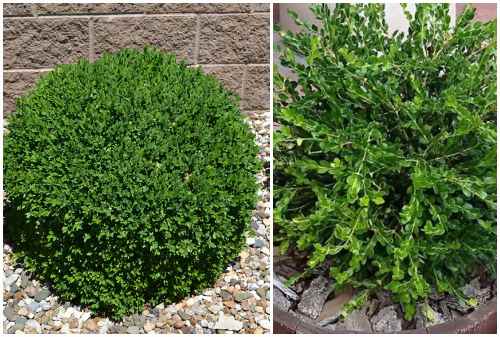

This type of boxwood is characterized by dwarf size and narrow oval leaves. He is a frequent resident of rock gardens, and is also grown at home.
Boxwood leaves and branches dry: why and what to do, video
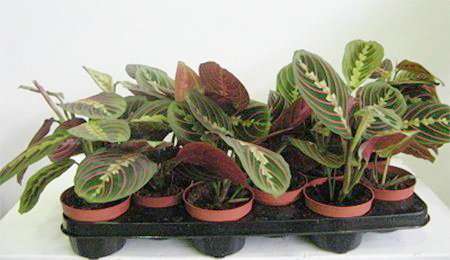

For landscape design, boxwood is an almost irreplaceable and widely used culture. This evergreen shrub is capable of growing in almost any climate, and even indoors. The plant has a beautiful decorative appearance due to the tough small leaves that generously cover the bush and retain their color throughout the year. Of no less importance is the fact that boxwood tolerates pruning very well and quickly forms new shoots. This property of the plant allows you to give it any shape, from strict geometric shapes to fanciful abstractions.
By its nature, boxwood should be, as they say, the same color in winter and summer. However, often an unpretentious perennial presents an unpleasant surprise to its owners - the leaves begin to change color, spots may appear on them, and over time, not only the foliage, but also the twigs themselves dry out.
The reason for this phenomenon may lie in one of the following factors or their combination:
- excess lighting;
- improper watering;
- lack of nutrition;
- low temperature;
- diseases;
- invasion of pests.
Lighting and air temperature


Boxwood grows best in partial shade. If you plant a bush in a sunny place, it will quickly lose its green color, so you should avoid areas where the plant will be in the sun throughout the day.
Direct sunlight is especially dangerous for perennials in the spring, and even at the end of winter, when there is a sharp warming after cold and gloomy winter days. During this period, boxwood is just beginning to wake up, and is very sensitive to the bright sun.
Some varieties of boxwood are also sensitive to low temperatures. In the long frosty winter, their leaves turn yellow and dry out from frost.
To protect the bush from the sun and frost, it is recommended to cover it with spandbond since winter, gradually opening the shelter. In the spring, you can also install a protective screen above the plantings, which will save the leaves from burns.
The introduction of potassium-predominant preparations in the fall will help boxwood to endure the winter more easily and strengthen its wood.
Errors in watering and feeding
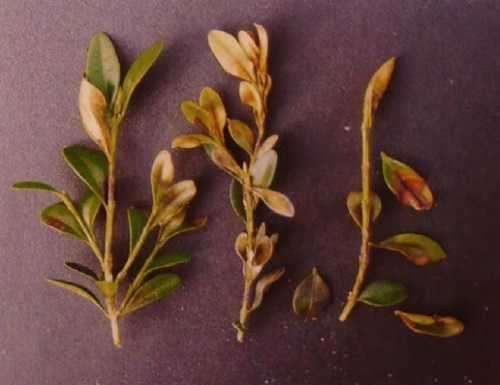

Drying of the leaves and branches of boxwood can be triggered by a lack of moisture. Despite the fact that the plant likes moderate watering, after pruning it needs additional moisture. If watering is insufficient, the bush will not only be unable to recover after cutting, but will also lose the remaining leaves.
At the same time, moisture stagnation under the bush should not be allowed - it will cause rotting of the root system and wilting of the bush.
Shelter boxwood for the winter
Winter and early spring are very difficult times for buksus. In winter, it gets very cold, and with the arrival of spring it can burn out in the warm sun.
Therefore, in order to save the tree, even before the onset of frost, it is necessary to well saturate the area with the plant with moisture and cover it with mulch (peat). Do not cover the soil with dry leaves, as it can cause fungi in boxwood. As the temperature drops to -10ºC, a shelter should be prepared from the cold.
If you have a standard tree, then they make a support for it so that the piercing winter wind does not damage the trunk, and wrap it with spruce branches. Bushy plants and those with a crown also need to be covered. For this, a non-woven material is used, which is wrapped a couple of times over a tree.
In order to avoid breaking branches under the weight of snow, they are tied. With the onset of spring, the shelter is immediately removed, since the buxus can rebuke. At the same time, one ball of shelter is left to protect the trees from burns by the warm spring sun.
How to transplant boxwood?
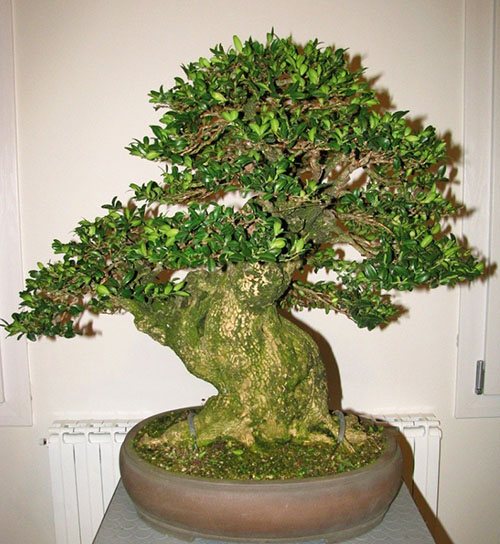

For transplanting young seedlings and already mature boxwood bushes, a soil mixture with a neutral reaction is needed, consisting of:
- two parts of humus;
- the same amount of sand;
- one part of sod land;
- a small amount of fine charcoal.
If the soil is too loose, add a little clay to it. This is especially important when planting a boxwood intended for bonsai and which subsequently does not transplant for a long time.
All types of boxwood require good drainage of fine gravel or stone chips with coarse sand.
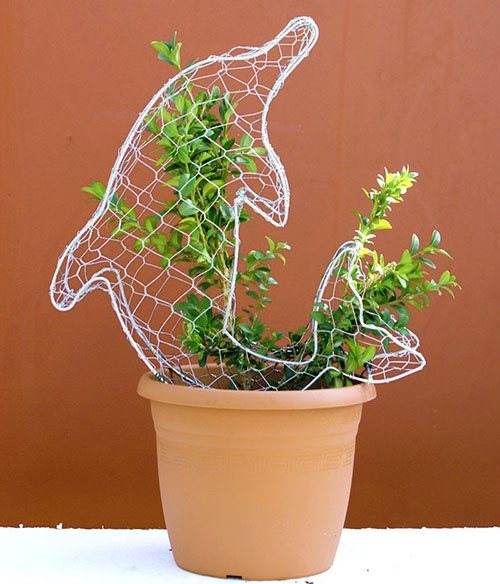

The best time to transplant is spring. During the warm months, the plant will have time to acclimatize, and winter will be less of a challenge for it. The new pot should not be overly large, especially when it comes to replanting an adult bush.


How to transplant store-bought boxwood with a closed root system? Often in such plants, the roots grow through the drainage holes, and inside the container they are woven into a tight ball. In this case, such a lump cannot be attempted to straighten or untangle. The roots that have got out on the walls of the pot are carefully cut flush with the bottom, the lump together with the peat soil is removed from the container and gently transferred into the prepared container and the prepared mixture is poured.
Boxwood seed
For reproduction of boxwood, a vegetative method is usually used, but sometimes the use of seeds is also found.
To grow buxus from seeds, you need to take only fresh seeds. They are poured for a day with warm water diluted with a growth stimulating agent. Next, they need to be placed between a pair of damp towels (but not wet). They will stay in this state for about thirty days. After 15-20 days, white shoots will appear.
With the formation of sprouts, seeds are sown in sand mixed with peat, while sprouts should go deeper into the substrate.
The containers with the planted material are covered with foil and kept in a warm, shaded place. After about 15-20 days, the first shoots will appear. After that, the film must be removed and the container with the boxwood must be moved to partial shade.
Young plants need to be watered and fertilized from time to time with a weak solution of dressings. The grown trees are planted in the soil when it becomes clear that frosts will not return.
1. Seven Secrets of Success:
| 1. Growing temperature: summer - 18 - 24 ° С, winter - it is advisable to provide a cool dormant period at a temperature of 3 - 8 ° С. |
| 2. Lighting: brightly lit location, plants should sunbathe in the morning and evening daily. Light shading should be organized during the daytime in spring and summer. |
| 3. Watering and humidity: irrigate with warm water during spring and summer in such a way as to dry out a layer of soil 2 - 3 cm thick between them. Reduce watering in autumn and protect the soil from complete drying out in winter. The air humidity is increased only to prevent the invasion of harmful insects. |
| 4. Pruning: formative pruning to maintain a beautiful shape, sanitary pruning as needed. Do not remove too many branches when pruning. |
| 5. Priming: nutritious soil, loose with good drainage, the pH of the soil should be between 6.5 and 7.2. |
| 6. Top dressing: every 2 weeks with liquid mineral fertilizers in half the concentration in the warm season. In autumn, fertilizing is reduced and in winter the plants are immersed in a dormant period, refusing to fertilize the flower. |
| 7. Reproduction: semi-ripe stem cuttings, by seed method. |
Botanical name: Buxus.
Home boxwood - family... Boxwood or boxwood.
Where grows... Asia, Mediterranean, Africa.
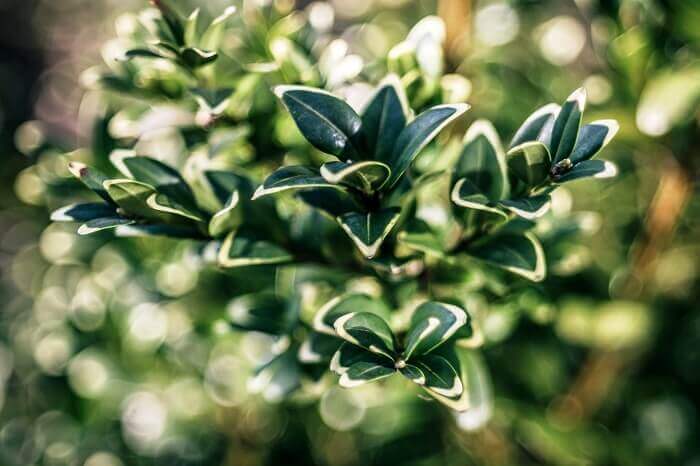

Description - what is boxwood... The genus "boxwood" or "buxus" includes about 70 evergreen shrubs or trees with small opposite leaves. Glossy, dark green leaves are simple, elliptical or lanceolate.The underside of the leaf blade is colored in a lighter shade. Small creamy flowers are collected in apical inflorescences. Blooming does not add any special beauty to the boxwood, but it will fill the room with a pleasant aroma. During the winter months, the leaves of the plant can turn bronze.
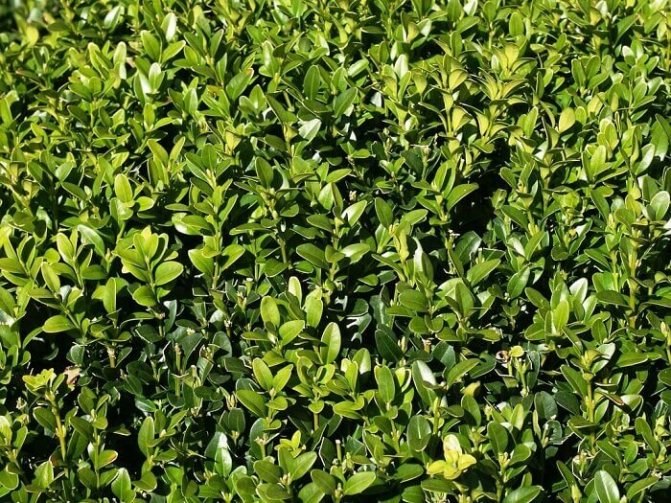

Height... House boxwood grows slowly. Reaches a height of 1 - 8 m in its natural environment.
Description of the plant
Evergreen boxwood, boxwood tree, stone tree, buxus - these are the names of the decorative evergreen shrub loved by landscape designers. The boxwood plant has about 30 varieties and is considered poisonous. This is a thermophilic evergreen plant found in the wild in Africa, Japan, Asia, Oceania. Even in Russia, there are two types of buxus: Hyrcanian and Colchis. It comes in shrub or tree form that grows more than 10 m in height.
Boxwood
- a favorite material of landscape designers, from this evergreen shrub you can sculpt not only winding hedges, geometric shapes, but also volumetric sculptural images. This quality is based on the peculiarities of the growth of the boxwood tree: it grows very slowly, increases by about 6 cm per year. Therefore, the trimmed shape of the shrub remains without deformation all year round with the same crown density.
Different types of boxwood are used depending on the purpose of use. For low hedges, one species is chosen, and for tall garden sculptures, several taller species planted together are suitable.
Growing conditions
Before planting boxwood correctly in the spring, you need to study the conditions for its cultivation. At home, boxwood requires careful and careful maintenance.
Lighting requirements
Boxwood likes a lit place, but does not tolerate direct sunlight. Under the scorching sun, the leaves of the plant turn yellow and dry. This often happens at the end of winter, when the root system is still asleep, and the foliage is waking up under intense sunlight.
The leaves do not get enough moisture and dry out, causing the boxwood bushes to burn out. To prevent this from happening bushes need to be covered
.
Temperature regime
At moderate temperatures, indoor boxwood grows well. But in winter it needs a temperature of + 6 ... + 10 ° С
... Boxwood loves open space, so in the summer it is better to take it out to the balcony or yard.
Combination of trees
Different types of trees get along with each other in different ways. Birch and linden, linden and alder, alder and rowan, rowan and ash, ash and willow, birch and willow, oak and maple, birch and spruce, spruce and cypress, alder and spruce live well close to each other.
Trees mutually extinguish their opportunities in the following combinations: poplar and maple, elm and boxwood, oak and ash, birch and pine.
There are also trees - individual farmers, which do not come into close contact with other species, but do not suffer from their neighborhood - these are cedar and yew.
Pests and diseases
Since boxwood is a poisonous bush, few pests can parasitize on it.
So, among the possible parasites:
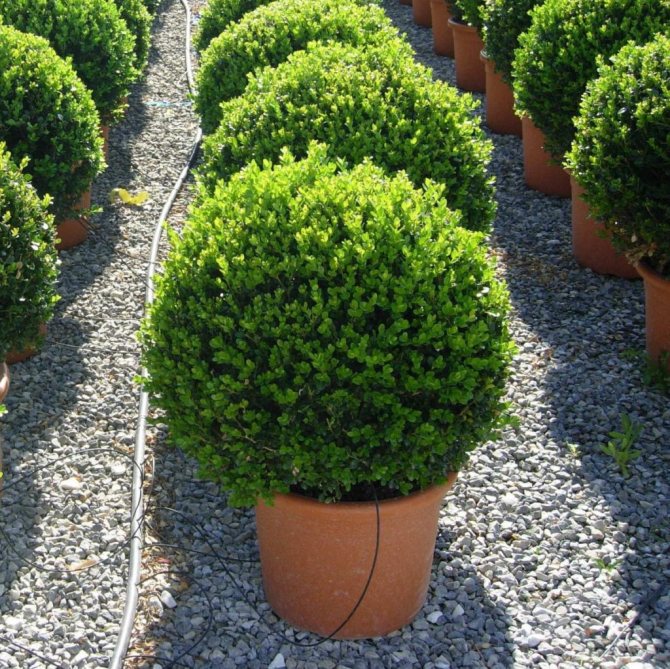

Fight fungal diseases, perhaps with the help of fungicides, which are sold in huge quantities in flower shops. I also pose a threat, gall-forming and spider mites. It is necessary to monitor watering and cut off the shoots affected by the mite. Boxwood felt is also an enemy to the plant. It often appears as a result of poor quality care. The affected areas of the bush - whether by insects, or as a result of the development of a fungus - are removed and the plant is treated with special chemical solutions. In some cases, you can resort to folk methods, use laundry soap, you can use kerosene against scale insects. Mineral oil (M-30, M-50) is effective against worms.
Watering boxwood
In general, caring for boxwood is not difficult, it follows the usual logic of caring for plants.
If it is hot outside and there is no rain, then water it every seven days. You need to use about 10 liters per meter tree.
If the weather is very dry, then you do not need to water more often, but you need to increase the amount of water. Following watering, the soil should be loosened and weeds removed.
In May, when it becomes quite warm, you need to cover the area with peat mulch, but do not allow the peat and the stem of the tree to come into contact.
Description of the appearance of the axle box, distribution
In the wild, the buxus reaches 12 meters, and the bushes grow up to 2 meters high.
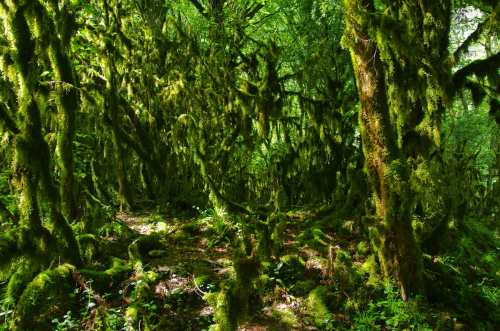

Small leaves are rounded and opposite. They are dense, leathery to the touch. The flowers are small, without petals, in appearance, absolutely nondescript, but fragrant. After pollination, a fruit is formed - a box, which, after ripening, begins to crack, which leads to the scattering of seeds.
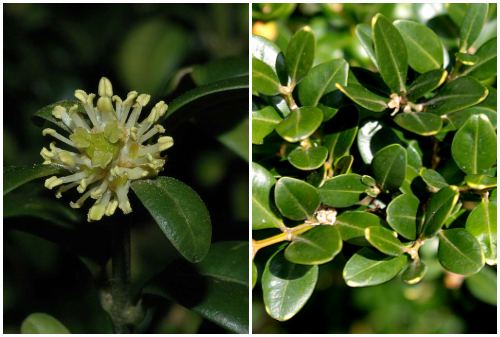

The culture is a good honey plant, but because of its toxicity, honey is not consumed.
Plants can live in almost any conditions: among shrubs, forest edges, in clearings, stony placers, shady deciduous forests. That is, he needs a soil with a slightly acidic reaction.
The habitat is quite diverse - these are the forest-steppes of Africa and Madagascar, Southern Europe, Asia, South and Central America. By the way, American species are the tallest, some specimens reach 20 meters in height.
Boxwood plant - description
The leaves of the boxwood are opposite, whole-edged, leathery, elliptical or almost round. The flowers are fragrant, small, unisexual, collected in axillary inflorescences. The fruit is a three-celled capsule, cracking when ripe and scattering shiny black seeds. Boxwood is a melliferous plant, but boxwood honey cannot be used, since all parts of the plant are poisonous. Landscapers prized boxwood for its beautiful crown, shiny leaves, and its ability to tolerate pruning. Gardeners, among other things, appreciate decorative boxwood for its unpretentiousness and shade tolerance.
Why is it worth planting boxwood on the site?
Why is it worth planting boxwood on the site?
Question:
What is the ideal site?
The answer is, or rather, three answers:
- The one that looks well-groomed - the lawns are trimmed, there are no weeds, the color and the trees look healthy;
- one on which not only fruits, vegetables, fruit trees and flowers are planted, but also useful plants;
- the one, looking at which the soul rejoices.
To achieve this harmony, gardeners plant ornamental shrubs. The main requirement for them is long-term preservation of an attractive appearance. The king among such plants is boxwood. Interesting fact: the word "boxwood" hides almost thirty species of plants. Outwardly, they are very similar, and it is easy for a layman to confuse one species with another. Gardeners have chosen only one among all and breed it in nurseries for sale. Wild individuals in gardens, parks and plots feel uncomfortable and often die. This is probably why it is recommended to purchase adapted boxwood in nurseries and follow all the recommendations of specialists when growing it.
So, boxwood on the site is needed:
- for beauty
- this shrub can be given any look, and this is very convenient when decorating curbs, front gardens, paths; boxwood grows very slowly, so it does not need a constant haircut, and this is another plus; - for a special
- healthy - air, because there are a lot of phytoncides in boxwood. They say that if only five boxwood bushes are planted on the site, then after three to four years the inhabitants of the house will forget about diseases of the upper respiratory tract. Immunity will get stronger, and all family members will feel much better. - for treatment:
boxwood is a real first-aid kit, lovers of traditional medicine treat them with all diseases, from colds to oncology.The temperature has risen? Have you eaten something stale and have a stomach ache? Does your heart hurt? Did the doctors find helminths in you? Headache and medications don't help? Bile stasis? We take a decoction of boxwood, and all diseases, as in a fairy tale, go away by themselves. Panacea? Maybe, but before preparing the broth, you should read the opinion of official medicine. And she treats boxwood with caution because of its high toxicity and constantly warns that self-medication is not doing good.
Before buying a shrub, you should study the growing conditions for boxwood. You need to start by choosing a place. Boxwood grows well in the shady corners of the garden, near the house - on its shady side. If there is no such place, then it is worth taking a closer look at the tall pines and firs. We plant a shrub near them, then it will grow in almost ideal conditions. Boxwood is especially picky about the composition of the soil - it should be slightly acidic.
The boxwood is not afraid of summer, the sun and heat do not affect its well-being and growth in any way, but this plant does not like the wind, especially in autumn. slightly acidic In November, the bush needs to be watered abundantly so that the roots have moisture for the winter. And be sure to add coniferous needles mixed with peat under the plant. But it is better not to use fallen leaves for mulching, because boxwood can become infected with fungus from them. Now we are constructing a heater in which the shrubs will spend the winter. We cover small bushes with a cloth (preferably non-woven); for adult plants that have a spherical shape, boxes will have to be made to size. Usually they are made from slabs, but you can buy a special plastic container at the store. The main thing here is not to be mistaken with the size. If the boxwood is grown for the curb, that is, it acts as a hedge, then it is best to wrap it in burlap and tie it tightly at the base of the bush. We cover the boxwood with boxes and cloth only after the temperature outside has dropped to minus ten.
In the spring, as soon as the above-zero temperature is established, we remove all heaters. We remove the needles, apply fertilizers, if necessary, then level the shape a little. A beautiful green ball is ready for its main job - decorating our site. Boxwood has a long life
- it has been growing for at least five hundred years, so our great-great-great-grandchildren will admire it and remember us with a good word.
Boxwood transplant
Transplanting a boxwood shouldn't be too difficult for you either. It is best to carry out the procedure in the spring, following the same steps as when planting. Mature plants must be moved to a new place along with the earthy clod.
In summer, the tree can also be replanted, but a not too hot spring is better for this.
In the fall, it is undesirable to start this procedure, because the plants after transplantation are quite sensitive, and they still need to take root and get used to the new growing place.


